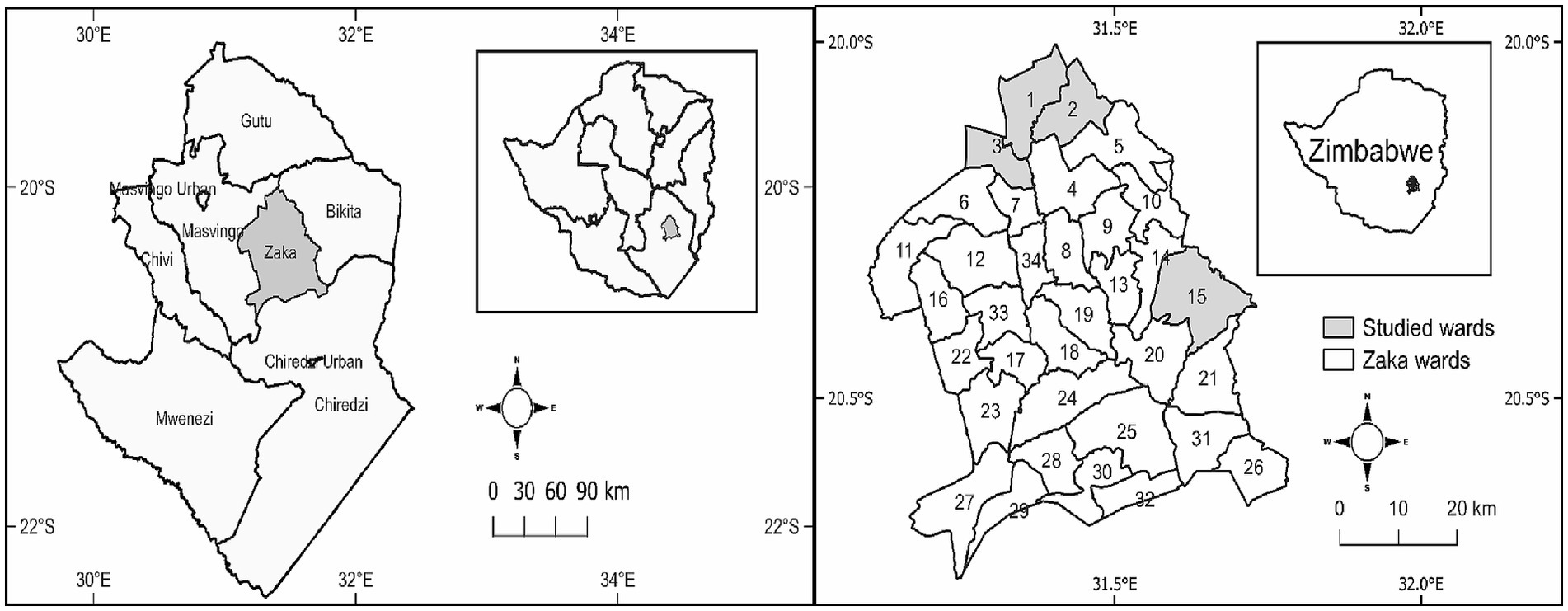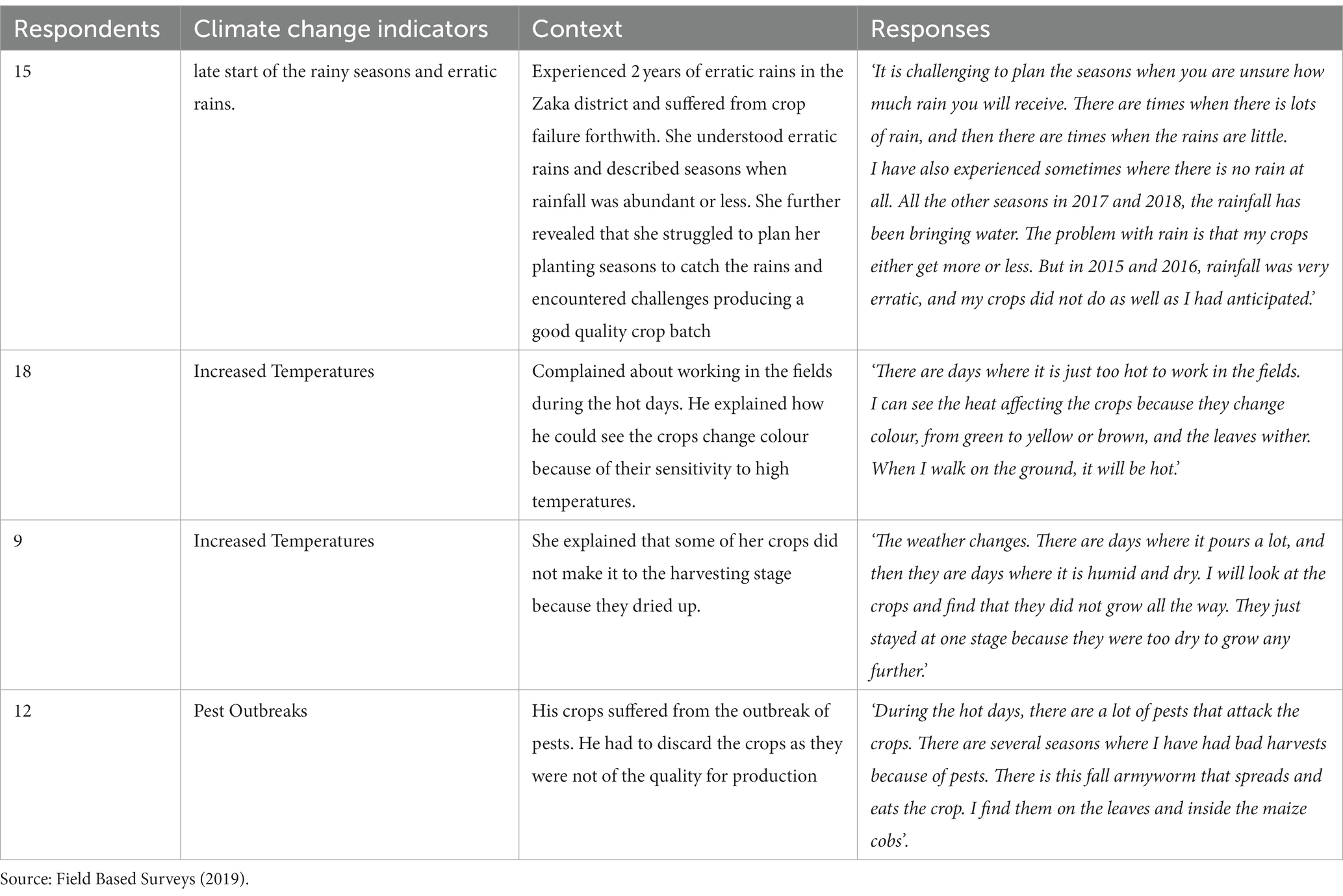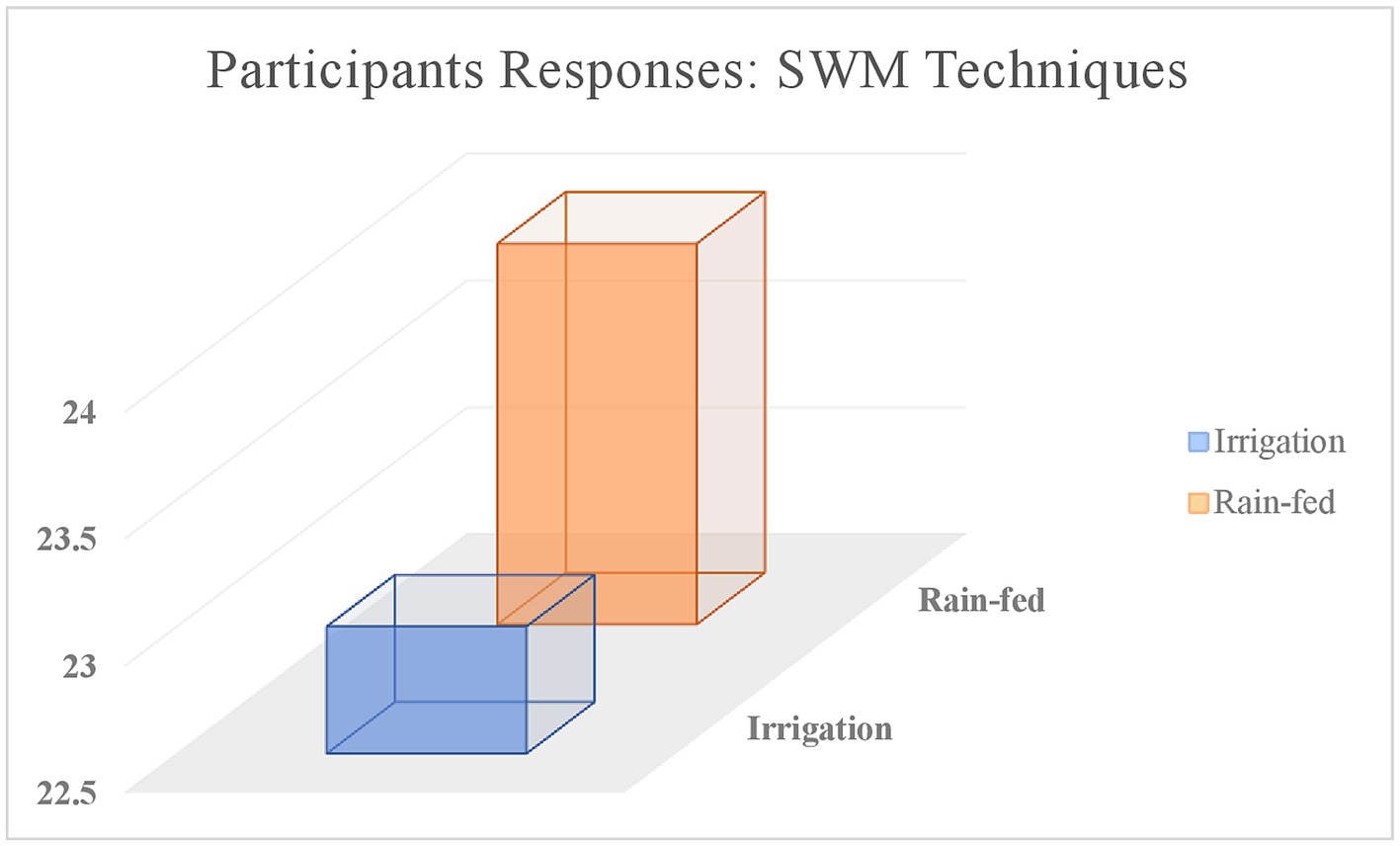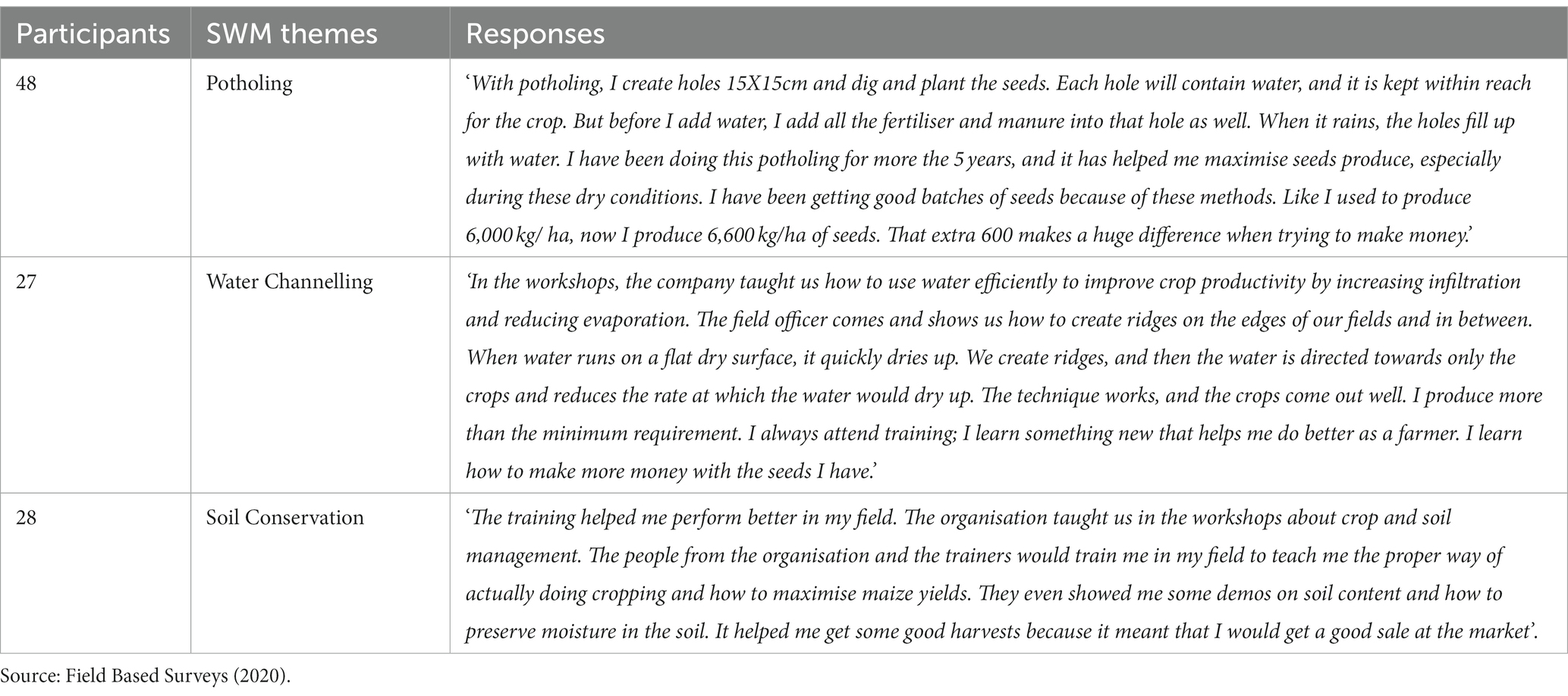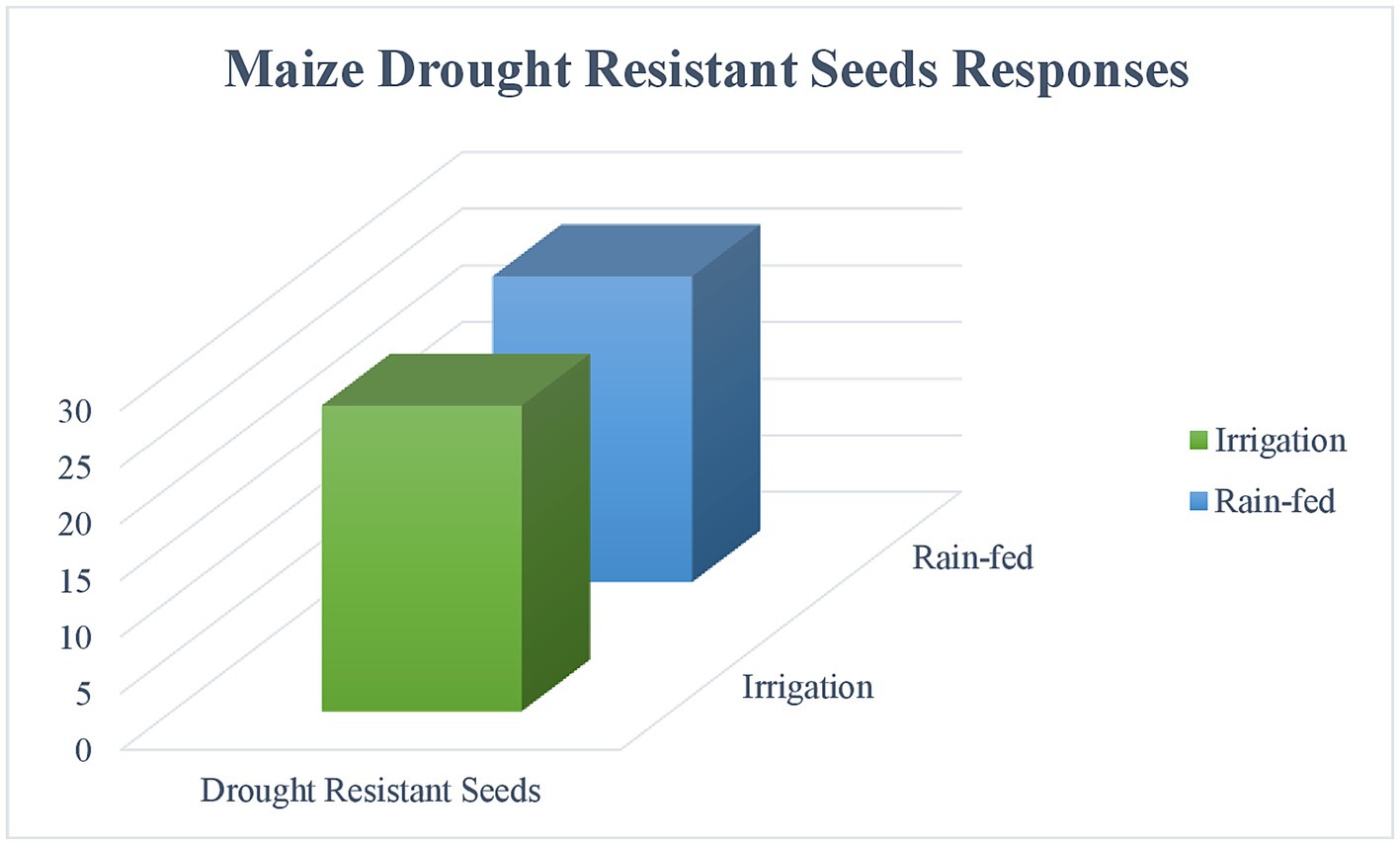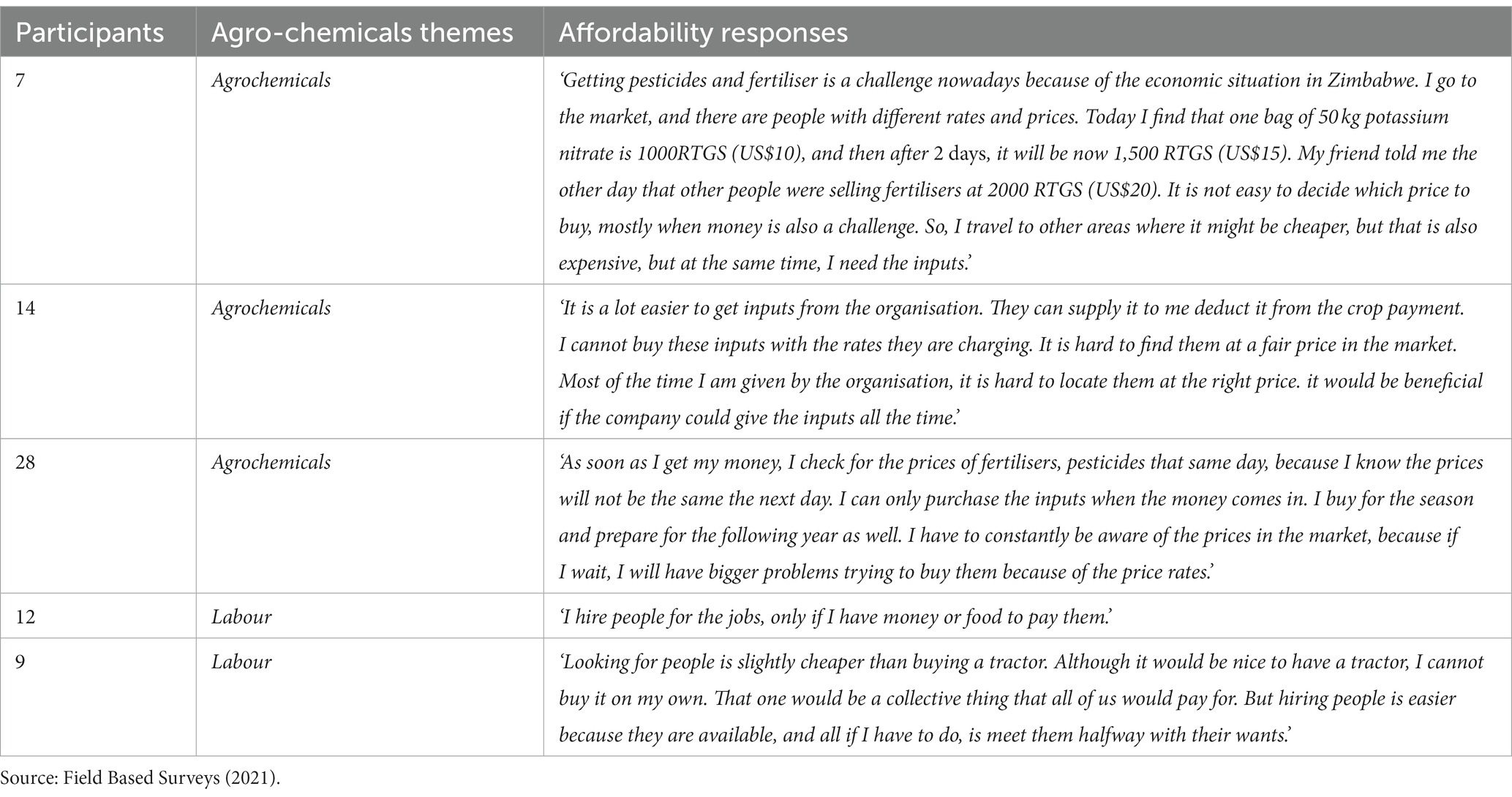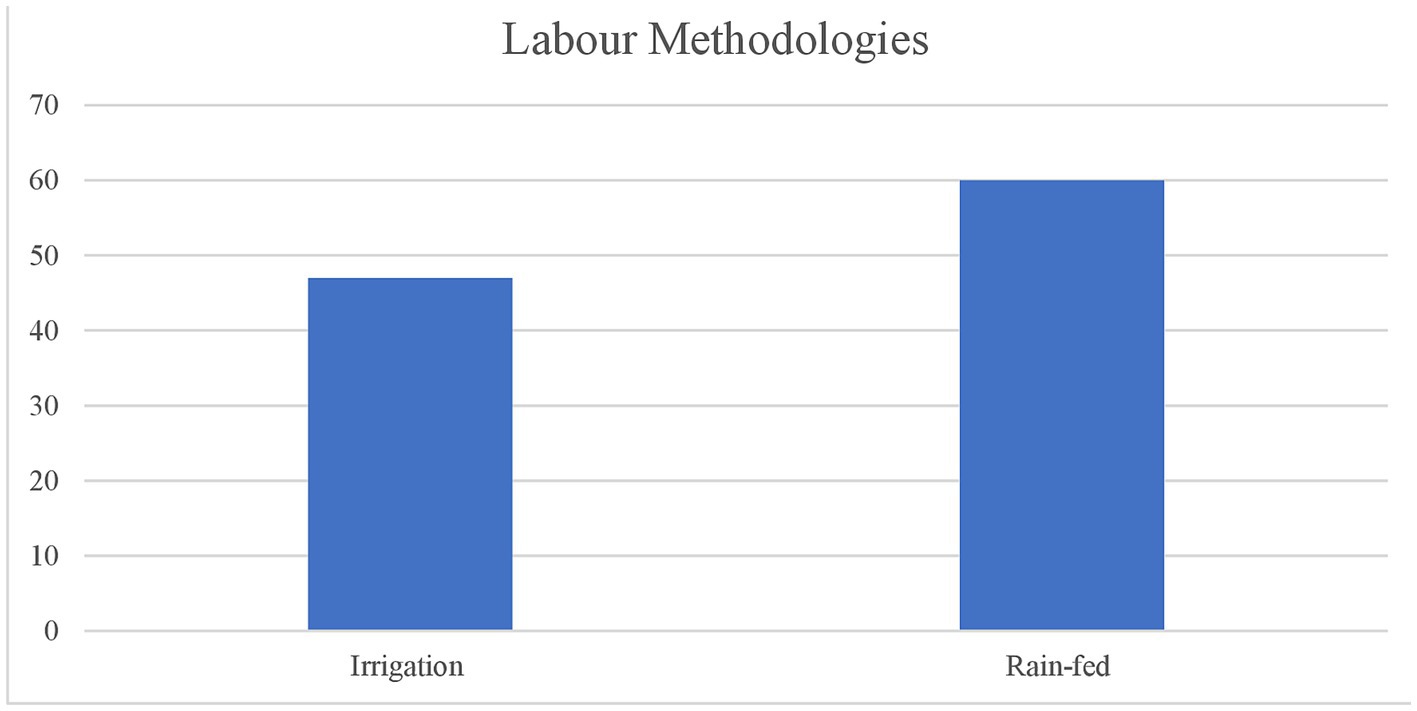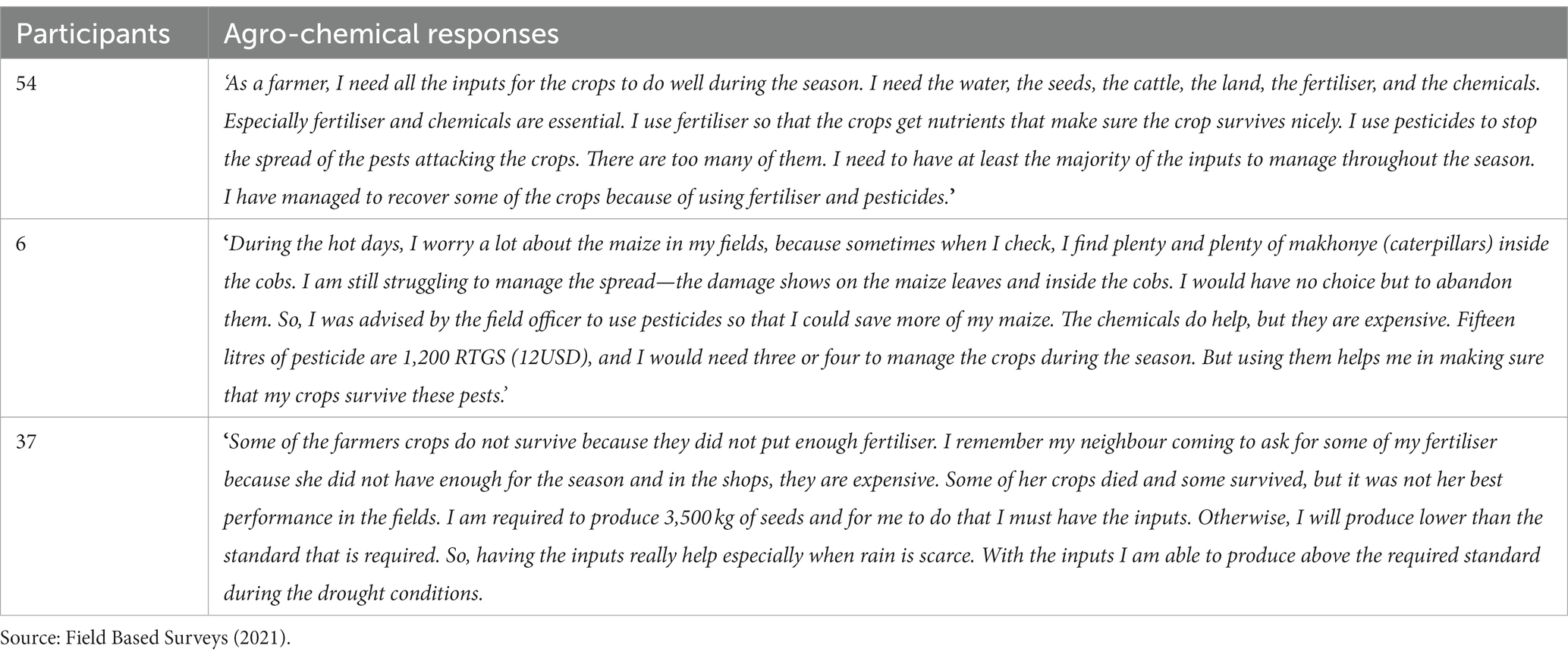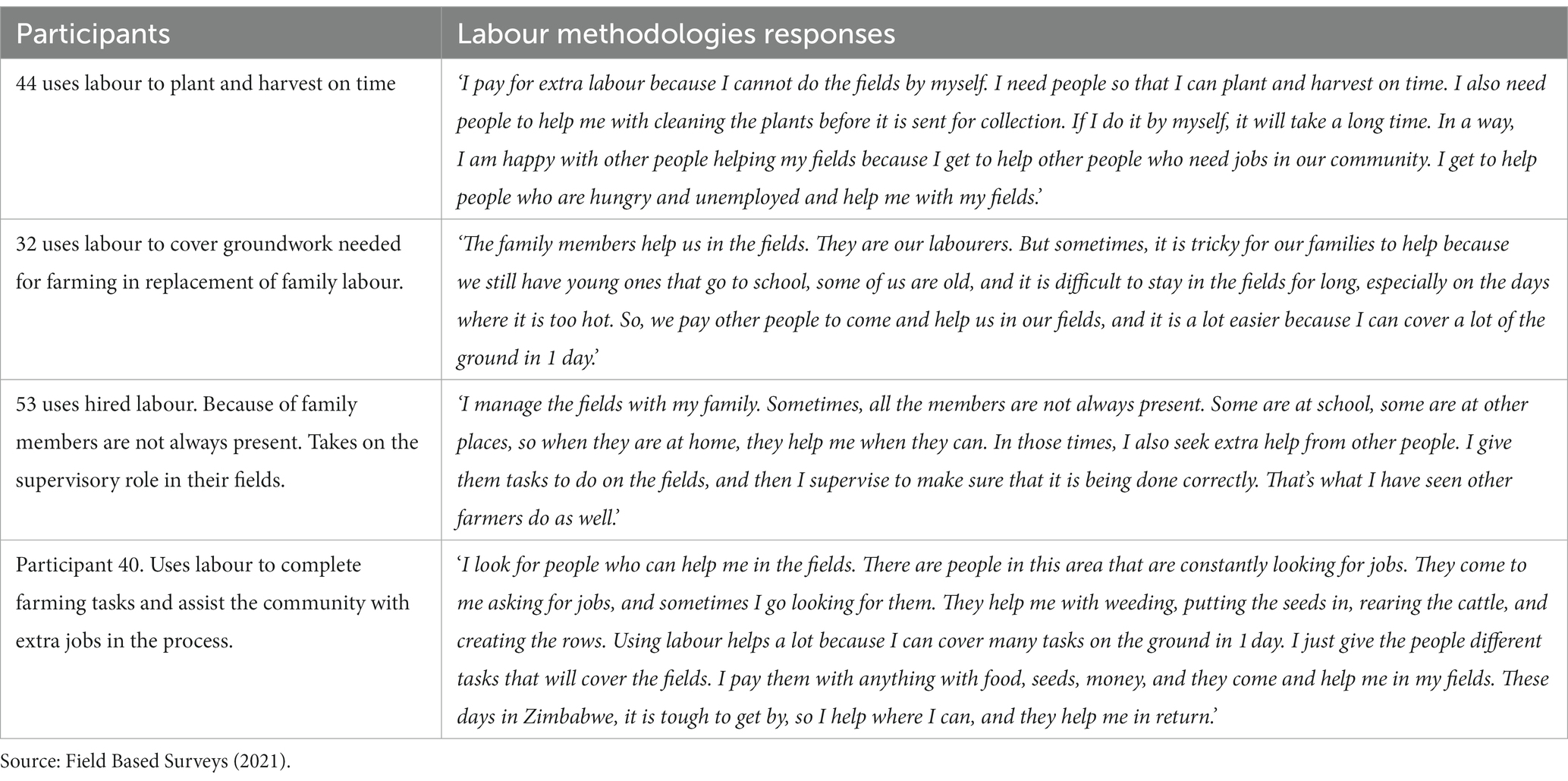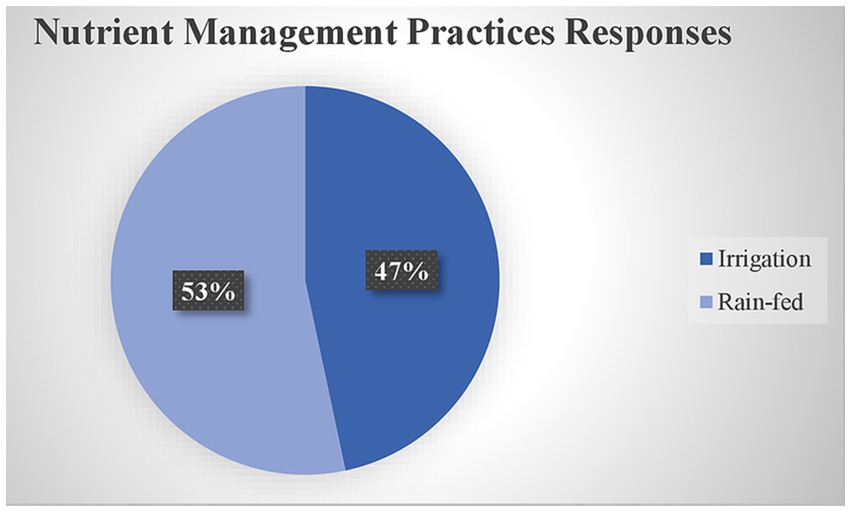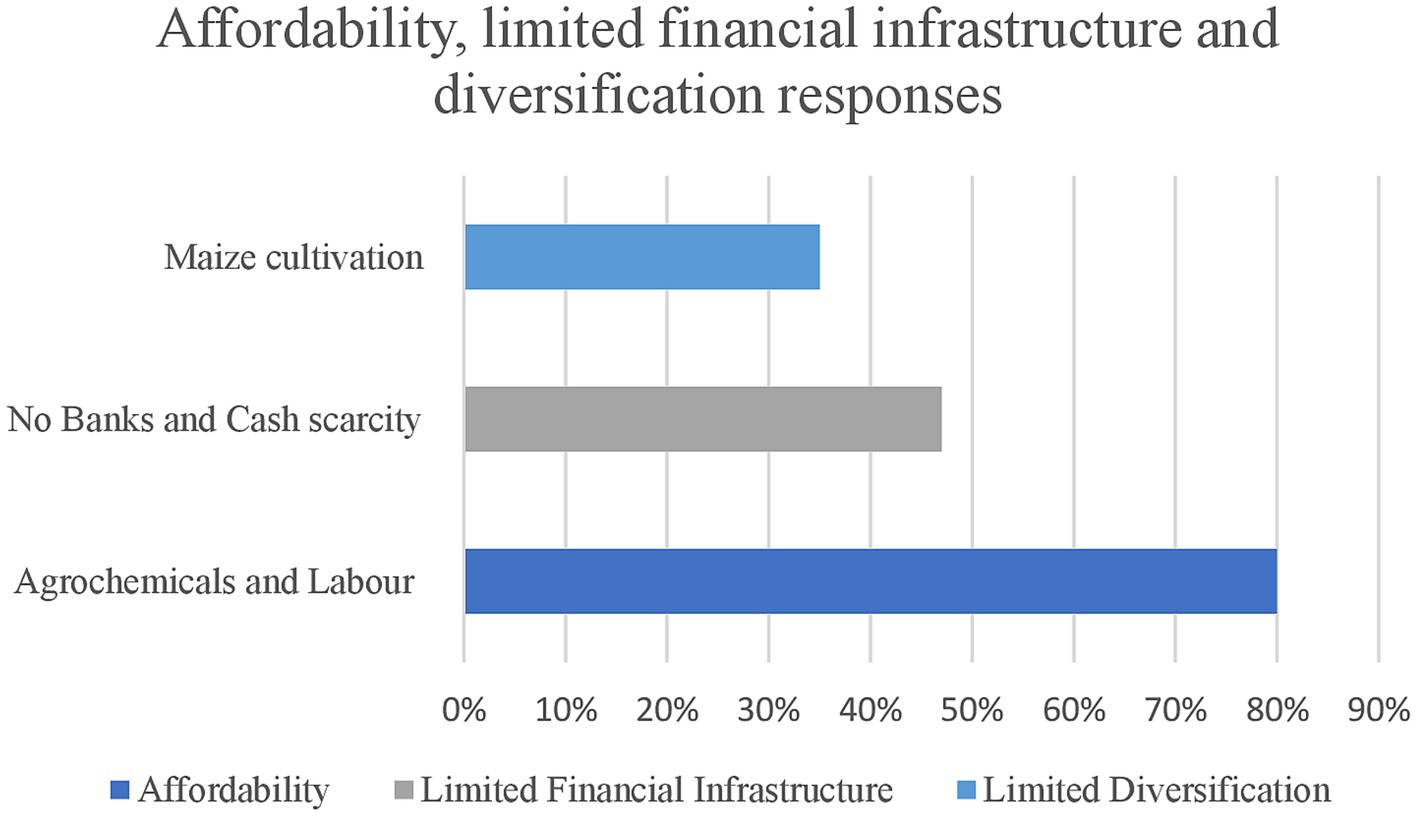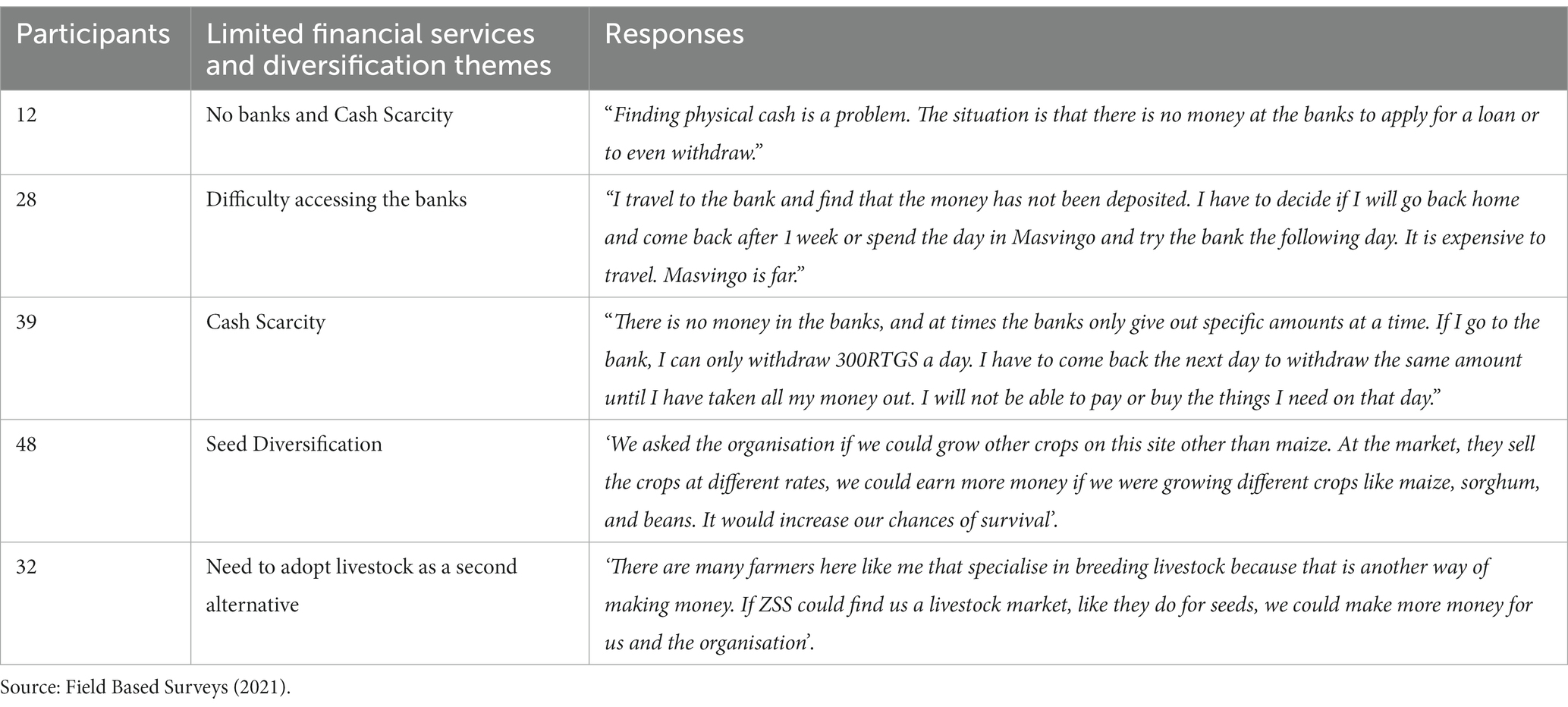- School of Geography, Archaeology and Environmental Studies, University of the Witwatersrand, Johannesburg, South Africa
Climate change is one of the most significant challenges many rural farmers face in sub-Saharan Africa, as most agricultural practices are rainfed dependent. Many of these rural farmers are small-scale farmers with limited access to financial assets, agricultural equipment, and inputs. With a rapidly changing climate and limited access to agricultural resources, many rural farmers in Zimbabwe have found it extremely difficult to engage in meaningful crop production activities and secure their livelihoods and incomes. This paper employs participatory research methods to examine adaptive strategies adopted by rural farmers. The strategies include optimal water resource utilisation, early maturing seed adoption, soil and water conservation (SWM), and nutrient management techniques (NMT). Cost-effective integration of labour and post-harvest storage facilities is also considered. Rural farmers, despite constraints, actively engage in these adaptive practices. The study assesses the effectiveness of initiatives to enhance crop production and build resilience against climate variability. Discussion centers on the comprehensiveness of these adaptive techniques within the broader framework of sustainable development goals, focusing on goals 1 (No Poverty) and 2 (Zero Hunger). The findings contribute to understanding and promoting resilience among vulnerable households facing climate-related challenges.
Introduction
In the context of climate change, poverty, and food insecurity in rural Zimbabwe (Brown et al., 2012; Muzari et al., 2014), farmers have demonstrated resilience by improving their ability to adapt to changing conditions through the adoption of climate-smart agricultural (CSA) practices (Brazier, 2017; Phiri et al., 2021).CSA is a globally recognised approach that enables farmers to address food and livelihood security issues while adapting to climate variations in an environmentally sustainable manner (Masipa, 2017; Brouziyne et al., 2023) with minimal greenhouse gas emissions (Kangogo et al., 2021). It takes a holistic approach to tackle the interconnected challenges of food security and climate change (Akzar and Amandaria, 2021; World Bank, 2023). Introduced by the Food and Agriculture Organization (FAO) in 2010, CSA gained rapid acceptance in many agricultural systems in Zimbabwe, particularly in Masvingo, where it aimed to alleviate the hardships faced by farmers dealing with elevated poverty rates, unemployment, increased crime rates, food insecurity, and nutritional deficiencies (Mango et al., 2014; ZIMSTAT, 2016; Zimbabwe Humanitarian Appeal Revision Report, 2020, 7). Success stories documented by Nyamangara et al. (2013); Mupaso et al. (2014), Hunter et al. (2020), and Phiri et al. (2021) emphasise how the adoption of CSA practices has improved farmers’ prospects of securing income, essential for accessing critical services such as healthcare, education, food, transportation, and agricultural extension services, all crucial for their well-being.
However, the multifaceted nature of climate-smart agriculture (CSA) practices requires a more comprehensive understanding of farmers’ perspectives and their appreciation of these strategies. While quantitative assessments have provided valuable insights into the outcomes and impacts of specific CSA practices, there is a significant gap in our understanding of farmers’ experiences, feelings, beliefs, attitudes, and challenges in adopting CSA strategies. This gap is particularly pronounced in sub-Saharan Africa, where CSA adoption rates are relatively low compared to other regions, and the factors influencing adoption are unique (Kangogo et al., 2021). Moyo et al. (2017), Mutambara and Munodawafa (2014) and Makate et al. (2019), highlight that the low adoption rates can be ascribed to a range of challenges, high costs of raw materials with the reluctance to integrate CSA practices with proven effectiveness into existing agricultural systems, overreliance on donor funding for expanding CSA initiatives, inadequacies in both formal and informal information systems, such as weak extension services, and the absence of effective agricultural support policies and institutional strategies, including credit availability, property rights, and market institutions, among other obstacles observed in Malawi and Zimbabwe.
It is essential to acknowledge that CSA practices are not universally applied and that various local factors, including climate variability, resource availability, political and socio-economic conditions, technological access, and policy frameworks, influence their effectiveness (Shava et al., 2009; Rurinda et al., 2014; Moyo et al., 2017). Therefore, incorporating farmers’ local knowledge and perspectives becomes crucial in developing practical and context-specific CSA strategies (Mubaya et al., 2012; Ogunyiola et al., 2022). Taking in to account farmers beliefs and attitudes in the design and implementation of CSA programs enhances their receptiveness and commitment to success.
To address this knowledge gap, qualitative research methods, such as in-depth interviews and focus group discussions, were employed to explore farmers’ perceptions of CSA strategies, the benefits they perceive and the barriers they encounter. These qualitative approaches yield nuanced and rich data, providing valuable insights, potential solutions, and recommendations from the farmers.
Our study investigated the feelings, beliefs, attitudes, benefits, and challenges associated with CSA strategies among Zaka farmers in the Masvingo district. By delving into their experiences and perspectives, we aimed to shed light on the implications of CSA for adaptive capacity within rural households. Our findings can inform future policy decisions, ensuring that CSA programs are enhanced and tailored to meet the adaptive capacity needs of farmers. By doing so, we contribute to the broader agenda of achieving the United Nations Sustainable Development Goals, particularly in food security, poverty alleviation, and climate resilience. As CSA programs continue to evolve, prioritising farmers’ perspectives and experiences becomes increasingly imperative in shaping the future of sustainable agriculture.
Materials and methods
Sampling and data collection
Zaka district encompasses 34 wards (Figure 1). This research aimed to identify and engage with small-scale farmers within these 34 wards. However, locating small-scale farmers across all 34 wards proved challenging, primarily due to outdated population records and restricted access to remote settings. Consequently, we adopted a strategic approach by enlisting the assistance of key informants to identify and locate small-scale farmers within the Zaka district. These key informants were selected from individuals with expertise in rural agricultural farming within Masvingo province, including academics, field experts, and government officers. It is important to note that Zimbabwean rural areas host various non-governmental and governmental organisations actively engaged in developmental projects to address poverty and food insecurity. Therefore, it was essential to engage with specialists within the Zaka district who had authority and were actively involved in the daily operations of rural communities.
One notable discovery during this research was the existence of the Zimbabwe Super Seeds (ZSS) private organisation. The selection of this organisation for inclusion in the study was intentional, as it played a pivotal role in delineating the wards actively involved in subsistence agriculture. ZSS had a well-established presence in addressing climate change- food-security related issues within the Zaka district and demonstrated a willingness to share their extensive knowledge on the subject. In pursuing this project, the study engaged in discussions with key personnel, including the project manager and field officer affiliated with ZSS, who provided valuable insights into identifying specific wards involved in subsistence agriculture. Zimbabwe Super Seeds is a private company that provides drought-resistant seeds and facilitates agricultural extension services and market access for small-scale farmers in Masvingo province.
The study found that ZSS manages 10 out of the 34 wards in the Zaka district. These 10 wards encompass rural farmers specialising in either dryland (rain-fed) or irrigated agriculture, and each ward comprises rural farmers engaged in distinct seed production activities. The 10 wards are numbered 1–6, 15, 16, 22, and 23. Wards 1–6 specialise in dryland farming, while 15, 16, 22, and 23 specialise in irrigation. The various seed projects undertaken in these wards encompass a range of crops, including maize (ZM309, ZM401, ZM521), sugar beans (NUA45, Gloria, Sweet Violet), cowpeas (CBC2, CBC3), sorghum (SV4), pearl millet (Okashana 1, PMV3), and groundnuts (ILanda). Among these crops, maize production held particular significance for this investigation, as maize is Zimbabwe’s traditional food crop and a cornerstone of food and nutrition for numerous rural communities, contributing substantially to local food security. The study had access to four wards based on subject availability, specifically wards 1–3 and 15 (Figure 1). Wards 1–3 consist of dryland farmers and Ward 15 consists of irrigation farmers. All four wards specialise in maize seed production, as detailed in Table 1.
The number of farmers in Table 1 varies, and in order to obtain a representative sample of farmers from each ward while accounting for the differences between wards, the study applied a 30% margin of error, as indicated in Table 2.
Considering the data presented in Table 2, a stratified sampling approach was employed to ensure that the final sample accurately represented the entire population, notably when the population displayed multiple characteristics with proportionate disparities. Table 2 divides the population into distinct subunits based on the 30% margin of error, with these subunits serving as strata within the population. It is important to note that the representative samples drawn from each subunit possess characteristics consistent with the overall population.
The population in Table 1 comprises two distinct strata sets, one comprising dryland farmers and the other of irrigation farmers. The ratio between these two strata groups is set at 14:10, indicating that for every 14 dryland farmers in the overall population, there are 10 irrigation farmers. Recognising that dryland and irrigation farmers may have distinct experiences and characteristics, it was essential to ensure that both strata sets were adequately and proportionately represented in the final sample—consequently, the sample needed to mirror the same ratio as the population to be considered truly representative.
As these two strata sets are based on different farming practices, a larger sample was drawn from the irrigation farmers compared to the dryland farmers, as shown in Table 3. The study employed a systematic approach to select the sample from the farmers’ contact list provided by ZSS. It involved using random sampling on the contact list with an interval of 10. For Wards 1–3, 10 individuals were randomly selected from the representative sample, totalling 30 dryland farmers in the study. In the case of Ward 15, an additional 20 individuals were added to the representative sample from the total number of farmers, constituting a group of 30 irrigation farmers in Table 3. This comprehensive approach resulted in a study population comprising 60 Zaka rural farmers, effectively ensuring a balanced representation of dryland and irrigation farmers within the research sample.
Traditional participatory approaches and analysis
The study employed traditional participatory approaches, which consisted of four focus group discussions that had 7–8 people with the dryland farmers and in-depth interviews with the irrigation farmers from the Zaka district in Masvingo, Zimbabwe. The data collection process commenced by transcribing raw data from interviews and focus group discussions. A thematic analysis which entailed systematically identifying codes within the transcribed data and classifying them into distinct thematic categories.
Results
Current climate change scenarios in Zaka district, Masvingo
The study commenced by engaging in discussions with the participants and key informants to gain insights into the prevailing climate change scenarios in Zaka District and to comprehend the Climate-Smart Agriculture (CSA) practices adopted by local farmers. Participants expressed that over the past 5 years, several climate-related factors significantly influenced their crop production (Figure 2). These factors included the outbreak of pests, erratic rainfall patterns, delayed onset of rainy seasons, and elevated temperatures. Notably, a majority of the interviewed participants perceived water scarcity as being closely intertwined with both the delayed onset of rainy seasons and erratic rainfall patterns. Other elements of drought, such as pest proliferation and increased temperatures, were also mentioned as indicators (Figure 2).
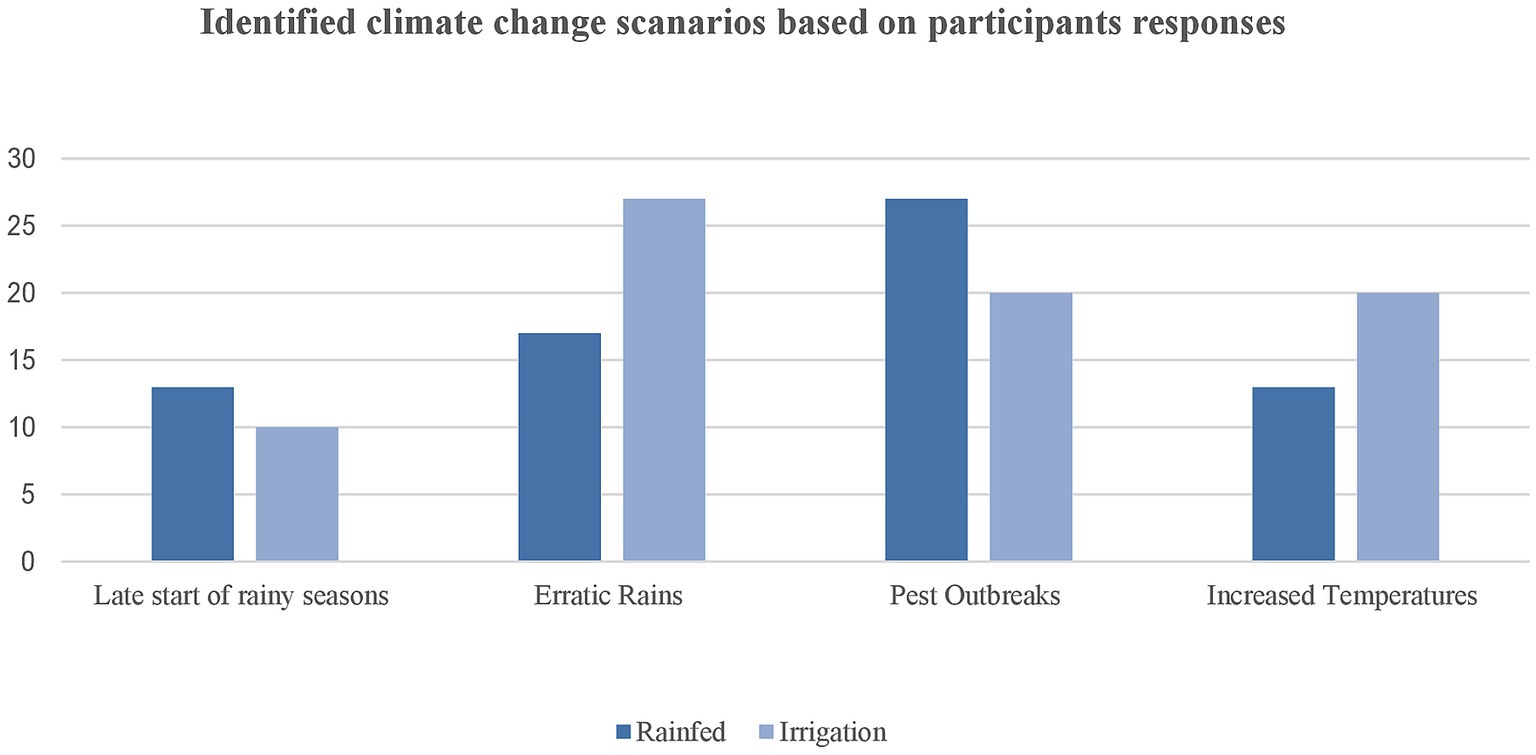
Figure 2. Identified climate change scenarios based on participants responses. Source: Field Based Surveys (2019).
In the context of erratic rainfall, a substantial proportion of the participants, 57% of rain-fed and 90% of irrigation farmers reported experiencing this issue. Additionally, 33% of irrigation and 44% of rain-fed farmers raised concerns regarding prolonged rainy seasons. The participants underscored how untimely rainfall adversely affected their planning, leading to issues like water scarcity and crop losses, with rain-dependent farmers being notably affected (as detailed in Table 4). Approximately 13% of rain-fed and 20% of irrigation participants also acknowledged the impact of climate change through an increase in hot days over the past 3 years. These hot days were recognised to cause physical discomfort and crop damage, subsequently affecting agricultural productivity in Zaka. Moreover, pest outbreaks, notably the armyworm, were documented by 90% of rain-fed and 67% of irrigated farmers, damaging maize leaves and cobs.
Adopted CSA practices by Zaka farmers to enhance crop productivity in response to identified climate change scenarios
Soil and water management techniques
77% of irrigation and 80% of rain-fed farmers confirmed that they had received training in soil and water management (SWM) techniques (Figure 3). Additionally, 78% of the 60 rural farmers surveyed actively incorporated these techniques into their CSA strategies.
The participants’ accounts provide insights into the substantial impact of SWM training on their perspectives, attitudes, and practical responses to the challenges associated with unpredictable rainfall patterns and rising temperatures. They underscored the significance of comprehending crop-specific attributes, such as growth rate, flowering and fruit set, nutrient requirements, temperature sensitivity, plant height, and soil moisture content, as pivotal factors contributing to improved crop yields.
Among the SWM techniques embraced by the participants were potholing, soil conservation, and water channelling. These strategies were acknowledged for their instrumental role in enhancing crop productivity. The participant feedback, presented in Table 5, reflects a range of positive experiences stemming from the tangible success they achieved with these techniques. Many participants reported meeting and surpassing their minimum yield expectations, resulting in increased income upon harvest.
As evident in Table 5, Participant 48 reported a noteworthy achievement, a 10% increase in crop yields over 5 years, primarily attributed to the dedicated adoption of the potholing technique. This technique involves the creation of small depressions in the soil, each measuring 15X15cm. The practice facilitates improved water retention and enhanced nutrient absorption, supporting sustained crop growth, particularly during dry periods. Similarly, Participant 28 experienced substantial enhancements in crop yields through the diligent implementation of soil management practices, which included water channelling and the preservation of soil fertility and moisture levels. It involved the mitigation of water losses in the soil due to evaporation and transpiration. These farmers were trained to construct ridges in their fields, thereby aiding water infiltration while simultaneously reducing evaporation.
These firsthand accounts from the participants underscore the pivotal roles of potholing and soil preservation tactics in promoting higher crop yields. They highlight the positive experiences and perceptions of the effectiveness of SWM techniques. Consequently, the responses in Table 5 underscore the critical importance of specific aspects of SWM techniques, such as potholing, water channelling, and soil fertility maintenance, in fostering sustainable and productive agricultural practices.
Drought resistant seeds
The results reveal a notable trend, with an approximate 90% adoption rate of drought-resistant seeds among irrigation and rainfed farmers (Figure 4). It is important to note that the adoption rate of DRS is high due to the support they receive from the organisation as indicated in Tables 6–8. The farmers can access to drought-resistant seeds without the need to source them elsewhere. However, it is important to note that the adoption rates of inputs are not similar for other categories of farmers in Zaka district as indicated by Participant 14 and 7 in Table 8. Communal farmers who are not affiliated with ZSS must consider the costs of acquiring drought-resistant seeds at retail prices, which may impact their adoption decisions. In contrast, farmers affiliated with ZSS are registered under the condition that they grow the seeds provided by the organisation, which incentivises their adoption of these specific germplasm seeds.
Despite the notion, the data strongly emphasises the widespread embrace of drought-resistant seeds as a crucial CSA strategy to enhance crop productivity in the face of recurring droughts, with 93% of the 60 participants actively incorporating these seeds into their farming practices (Figure 4). Participant 12 provided a vivid account of their personal experience, attesting to a doubling of grain yield, from 50 kg to 100 kg, achieved through utilising specific maize seed varieties renowned for their drought resistance (Table 7). Participant 16 confirmed these sentiments, underscoring the remarkable quality of these selected seeds: their minimal water requirements for crop growth, even under scorching climatic conditions. Participants highlighted a similar notion explaining the pivotal role of the attributes of drought-resistant seeds in effectively addressing challenges posed by drought. These attributes were characterised by early maturation, white semi-flint maize varieties with resistance to maize streak virus, exemplified by ZM309, ZM401, and ZM521 maize Drought-Resistant Seeds (DRS) (Table 6).
Participants consistently identified these attributes as the cornerstone of their CSA strategies for increasing crop yields during elevated temperatures and mitigating the inherent risks associated with crop failure (Table 7). We cross-referenced the responses with the project manager in 2020, it was confirmed that achieving a double yield increase, as mentioned by one of the participants, is not a typical or guaranteed outcome. The variability is attributed to dynamic climate conditions and economic challenges in Zimbabwe. Nevertheless, the project manager did emphasise that they consistently observe significant improvements in farmers’ crop yields when using drought-resistant seeds compared to regular maize seeds. This enhancement is supported by crop productivity records (Figure 5), ultimately contributing to improved productivity and long-term income for farmers.
Survey records further substantiate the robust qualities of the maize seed varieties possessed by the participants, affirming their confidence in these seeds as invaluable tools for advancing agricultural productivity.
Nutrient management practices
The findings from focus group discussions and interviews revealed a substantial adoption of nutrient management practices (NMPs) among the participants. Specifically, 47% of irrigation and 53 percent of rainfed farmers actively incorporated NMPs into their agricultural practices to enhance crop yields (Figure 6). Overall, this highlights that 50% of the farmers acknowledged the significance of NMPs as a pivotal CSA strategy for safeguarding crop growth against the adverse impacts of drought (Figure 6).
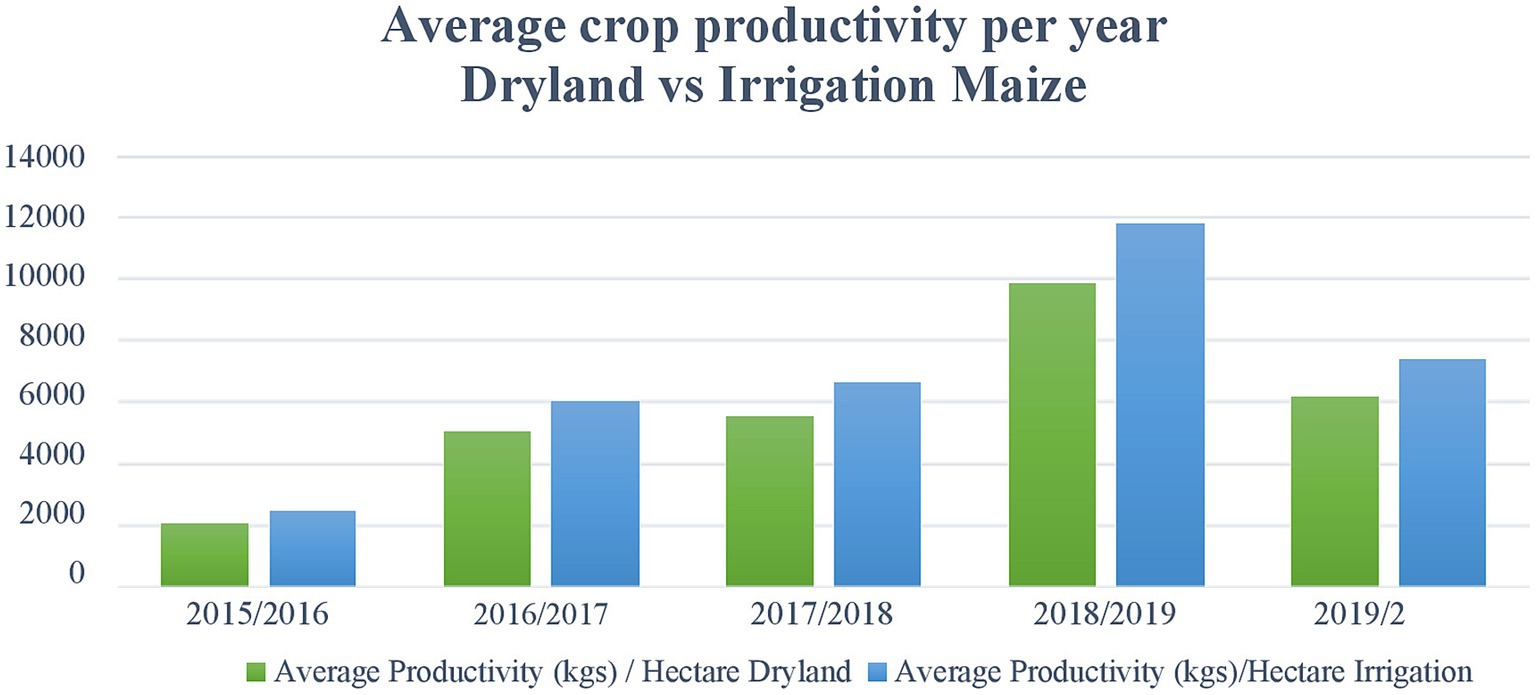
Figure 6. Crop productivity records per scheme: dryland vs. irrigation 2015–2020. Source: Zimbabwe Super Seeds (2020).
The data presented in Table 9 provides valuable insights into the systematic and practical utilisation of fertilisers and pesticides, as reported by the participants. According to the data collected during the field survey, several critical aspects of Nutrient Management Practices (NMP) among Zaka farmers were revealed.
In the Masvingo region, farmers are distributed across agro-ecological regions 2, 3, and 4, a distribution primarily determined by the local rainfall and water availability conditions. Lower regions tend to receive higher amounts of rainfall, while higher regions experience lower precipitation. The farmers interviewed predominantly reside in regions 3 and 4, with notably low annual rainfall averages, typically falling below 600 mm. Consequently, applying basal fertilisers and top-dressing practices exhibits variations within these regions.
For farmers in Wards 1, 2, and 3, the application of basal fertilisers is made at rates ranging from 250 to 350 kg/ha, along with top-dressing rates varying between 250 and 300 kg/ha for maize cultivation. In contrast, Ward 15, housing irrigation farmers, employs higher basal fertiliser rates within the range of 450-500 kg/ha, complemented by equivalent top-dressing rates. These disparities in application rates are contingent upon factors like soil nutrient content, the presence of potassium, nitrogen, and phosphorus in the soil, and the expected yield per hectare.
It is noteworthy that irrigation farmers are allocated 1.5 hectares due to access to water resources provided by ZINWA. On the other hand, rainfed farmers are allocated larger plots, covering 2 ha, to mitigate the risks associated with lower rainfall levels. Consequently, the yield per hectare differs, with Wards 1, 2, and 3 achieving approximately 6 tonnes per hectare and Ward 15 realising a higher yield of 12 tonnes per hectare. Soil characteristics also play a pivotal role in fertiliser efficiency, with Wards 1, 2, 3, and 15 predominantly featuring white sandy loam soils. These soils facilitate more efficient nutrient absorption compared to clay soils found in other regions.
These farmers demonstrated a meticulous approach to implementing specific Nutrient Management Practices (NMPs), focusing on the precise application of agrochemicals tailored to the unique requirements of their crops. Their proactive stance was evident in the timely procurement of agrochemicals, ensuring a continuous and uninterrupted supply of essential nutrients throughout the dry season. Participants underscored the indispensable practice of soil quality assessment, commonly called soil testing, as an integral aspect of their agricultural activities during the growing season. This assessment allowed them to fine-tune crop nutrition to align with the specific needs of their crops.
Furthermore, participants shared insights into their engagement with Integrated Pest Management (IPM) strategies, encompassing selective pesticide use, crop rotation, biological controls, and meticulous record-keeping for each ploughing season. The knowledge and skills necessary for these practices were acquired through training provided by Zimbabwe Super Seeds (ZSS). The strategic utilisation of agrochemicals assumed paramount importance, enabling participants to effectively address.
Labour methodologies
The data reveals a deliberate adoption of labour methodologies by agricultural participants confronting the challenges posed by climate change scenarios. A detailed statistical analysis further highlights the significant adoption of these labour-strategies, with 60% of rain-fed and 47% of irrigation participants choosing to employ these methods to effectively manage the complexities of modern farming under the influence of climate-induced adversities (Figure 5).
The labour strategies, as explained, encompass a wide range of human and animal resources, including family members, friends, cattle, neighbours, and labourers within the community. Participant 40, a 58-year-old farmer with extensive experience, featured in Table 10, articulated his proactive approach during the focus group discussions. He actively sought hired labour to manage various essential tasks, such as weeding, crop clearing, and cattle management for cultivation and harvesting purposes. His account underscores the recruitment of local community individuals actively seeking employment opportunities and their integral roles in assisting with various farming activities, including weeding, seeding, cattle management, and row preparation. This strategic utilisation of external labour provided distinct advantages, enabling efficient task completion within a single day. As a show of reciprocity, he compensated these valuable contributors with items like food, seeds, and monetary payments, illustrating the symbiotic nature of these collaborative arrangements.
Participant 32, as shown in Table 10, shared insights into her family’s central role in diligently covering essential groundwork whenever available. However, she also recognised the need to proactively engage labourers from her community to fulfil indispensable tasks when her family members were unavailable.
The detailed data in Table 10 collectively underscores the participants’ astute recognition of the critical importance of additional labour in their complex agricultural endeavours. They effectively communicated their awareness that farming tasks, from intricate processes like maize planting to meticulous phases like harvesting and maize cob cleaning, often required a labour force that extended beyond the capacities of their immediate families. Consequently, they consistently expressed the need for external labour to facilitate the timely and efficient execution of these multifaceted tasks. This shared understanding holds profound implications, emphasising the pivotal role of labour productivity as an indispensable component in achieving optimal farm output. This significance is particularly pronounced in an agricultural landscape susceptible to the unpredictable influences of variable weather conditions.
Crop productivity records per scheme 2015–2020: dryland vs. irrigation
The bar graph compares the groups between the rainfed and irrigation scheme’s crop production for 5 years from 2019 to 2020 (Figure 6). It is important to note that calculations were drawn on all the rainfed and irrigation schemes specialised in maize production under the Zimbabwe Super Seeds scheme. The data shows a gradual increase in crop productivity from 2015 to 2019 for both schemes and results from Tables 4–9 suggest that it is due to the participants adoption of CSA strategies. The lowest production levels were observed in the 2015–2016 and 2019–2020 periods, while the highest was in 2018 and 2019, while 2015 and 2016 were, respectively, observed as drought years. In comparing the two schemes the graph demonstrates that irrigation schemes outperformed rain-fed schemes in terms of crop productivity, whereas dryland yielded an average of 5039kgs per hectare. The results in Tables 4–9 and Figure 5 suggest that participants from Zaka district appreciate CSA practices as it has safeguarded them over the years from the risks of crop failures.
CSA limitations based on participant responses
The participants were asked what challenges they had experienced in applying CSA techniques. The findings indicated that the effectiveness of CSA strategies in enhancing crop productivity was significantly hindered by two main factors: affordability and limited financial infrastructure and limited diversification, as highlighted by maize cultivation, cash scarcity, agrochemicals, and labour (Figure 8).
Affordability and limited financial services
80% of the participants, rainfed and irrigation, expressed that hiring labour, applying agrochemicals, specifically pesticides and fertiliser was subject to price affordability (Figure 8). When participants could not afford the labourers price, agrochemicals, they struggled to enhance crop productivity. This was a serious limitation among the participants. Financial constraint is a critical factor in their decisions in Table 8 and it underscores the practicality of hiring labour and buying agrochemicals. They all expressed that CSA adoption strategies are ineffective if the raw materials come at a cost (Table 8). Responses suggest that the affordability of agrochemicals and labour plays an impact on the effectiveness of nutrient management strategies depending on the participants’ income and price opportunity costs.
A substantial proportion of participants, amounting to 47%, highlighted the issue of limited access to financial services, while an additional 35 % underscored the challenge of limited diversification. The narratives provided by several participants shed light on the specific hardships associated with limited financial services in Zimbabwe, elucidating two primary obstacles that stand out prominently. Firstly, participants emphasised the geographical constraint of the central banking administration, which is predominantly located in Masvingo. This spatial concentration creates a significant obstacle for participants residing in outlying areas, as they must contend with the inconvenience and costs associated with travelling to access financial services. Secondly, the accessibility of funds within the banking establishments proved another formidable challenge. Participants revealed that the availability of funds was contingent upon the physical presence of cash within the banks. This condition hindered their ability to secure loans or make withdrawals when needed, impeding their capacity to allocate the requisite funds to implement their CSA strategies effectively in 2020 and 2021. For instance, in Table 11, Participant 12 candidly expressed the difficulty of obtaining physical cash. Participant 28 further underscored the financial burden imposed by the geographical constraints. Participant 39 illuminated the scarcity of funds within the banking systems. These accounts in Table 11 collectively highlight the multifaceted challenges participants face in accessing financial opportunities critical for their agricultural activities. The constraints encompass the financial burden of travel, difficulties in securing loans, limited access to the required monetary sums, and the consequent inability to procure essential services promptly. These challenges significantly impede their pursuit of effective CSA strategies and underscore the pressing need for interventions that address the financial impediments hampering their agricultural endeavours.
Limited diversification
35% of participants reported limited diversification (Figure 8). Participants stated their fixed income was only maize production with Zimbabwe Super Seeds. For instance, in Table 11, Participant 48 said that growing other crops would improve their income-generating chances. Participant 32 reported a similar notion stating that growing livestock would increase their chances of survival if crop production were not always sufficient. The key result is that limited diversification limits their options for increasing CSA practices as they are restricted in benefits and thus subject to lower productivity and sustainability outcomes.
Discussion
CSA practices adopted by Zaka rural farmers in Masvingo
Soil water management techniques
Our comprehensive investigation into adopting CSA practices by Zaka rural farmers in Masvingo aligns with the established scholarly literature in the field. The incorporation of drought-tolerant crops, the application of soil and water harvesting based techniques, the different labour practices, and the adoption of nutrient management approaches have yielded positive outcomes, contributing to the development of adaptive farming systems that enhance productivity and safeguard the livelihoods of these committed farmers (Wauters et al., 2010; Girvetz et al., 2017; Makate, 2019).
The empirical insights extracted from the farmers’ responses underscore the pivotal role played by soil and water management (SWM) techniques in shaping these adaptive farming systems and steadily enhancing productivity. Particular recognition is given to the practical utilisation of potholing and water channelling. Furthermore, the valuable training provided by Zimbabwe Super Seeds (ZSS) has emerged as a catalytic force, deepening farmers’ understanding of CSA practices and equipping them with the knowledge and skills necessary for independent implementation. In the Zaka district, the training regimen covered essential techniques such as creating small 15x15cm depressions in the soil, judiciously integrating fertilisers, and adopting ridge formation along field edges and within fields. These interventions facilitated improved water filtration and nutrient absorption, resulting in noticeable yield increases (Figure 5). This outcome carries profound significance, extending beyond agricultural productivity, highlighting the multifaceted benefits of this process, including enhanced problem-solving skills, and increased personal fulfilment among the farmers, further underscoring the transformative potential of CSA strategies (Girvetz et al., 2017; Makate, 2019).
The efficacy of potholing and water channelling, often referred to as water harvesting in specific scholarly contexts (e.g., Ndlovu et al., 2020; Olabanji et al., 2020; Bagheri and Teymouri, 2022; Gebre et al., 2022), as integral components of CSA strategies has garnered considerable attention within the realms of climate change and agricultural discourse (e.g., Mavesere and Dzawanda, 2022). Potholing, a cornerstone of the farming approach known as Pfumvudza in Zimbabwe, has gained particular prominence in this discussion. This indigenous term encapsulates the conservation-oriented methodology embraced by rural farmers in Zimbabwe, emphasising its pivotal role in attaining elevated maize production levels and providing rural households with a sustainable source of food (Mavesere and Dzawanda, 2022).
The successful assimilation of Pfumvudza practices resonates profoundly with the experiences of the Zaka rural farmers, further corroborating these techniques’ potency in propelling agricultural productivity and fortifying food security for Zimbabwe. These findings harmonise with the conclusions drawn from Mavesere and Dzawanda (2022) study, substantiating the pivotal import of potholing and water channelling within the larger CSA framework. These methodologies empower farmers to set their sights on bountiful crop yields while enhancing resilience to mitigate the adverse ramifications of drought and water scarcity.
The resounding adoption of these techniques among Zaka rural farmers underscores their immense potential and beckons towards a broader adoption that could unleash their transformative impact on rural livelihoods and galvanise food self-sufficiency initiatives.
Drought tolerant seeds
Our study’s findings agree with the extensive research conducted by Cacho et al. (2020), who have strongly emphasised the critical role of adopting drought-resistant seeds as a vital adaptation strategy for vulnerable farmers in sub-Saharan Africa. This overarching objective is closely aligned with Sustainable Development Goal 2, which aims to end hunger, achieve food security, and promote sustainable agriculture worldwide. The adoption of drought-resistant seeds, as observed among Zaka farmers, represents a seemingly simple yet highly effective adaptation strategy. These farmers intelligently harness the inherent characteristics of such seeds, which include faster development, increased disease resistance, and an optimal growth environment for germplasm as highlighted in Table 6. Significantly, the efficacy of these seeds is further enhanced when no discernible issues related to taste, colour, and other plant attributes are encountered.
In line with these findings, the comprehensive research conducted by Habte et al. (2023) in Uganda provides additional support. Habte and colleagues’ investigations shed light on the significant advantages offered to farmers who embrace drought-tolerant seeds, especially in maize cultivation. Their empirical evidence highlights that farmers who opt for drought-tolerant maize seeds achieve significantly better crop performance than those who stick with non-drought-tolerant varieties. Notably, their study revealed a 47% increase in yield for farmers adopting drought-tolerant seeds compared to their non-adopting counterparts, demonstrating the transformative potential of this adaptation strategy.
Our findings also align with those of Simtowe et al. (2019) regarding the benefits of drought-tolerant varieties in enhancing productivity, improving yield stability, and reducing risk exposure. Simtowe et al. (2019) found in their study in Uganda that adopting drought-tolerant maize varieties increased by 15% and reduced the probability of crop failure by 30%. These observations resonate with the narratives of Zaka rural farmers, exemplified by Participant 12, who shared a compelling account of a twofold increase in grain yield, surging from 50 kg to 100 kg (Table 7). The progress was inherently entwined with the distinctive qualities of the adopted seeds, including their early maturation (110–120 days), resilience to drought-prone environments, and resistance to the pernicious maize streak virus, as meticulously documented in Table 6. These attributes collectively contribute to the marked enhancement of crop yields and the concomitant reduction in susceptibility to drought-induced crop failures. The tangible outcomes of this adoption extend well beyond agricultural productivity, profoundly impacting food security and the welfare status of maize-dependent households. The amplified yields (Figure 6) translate into improved crop income and a surplus of marketable produce, thereby tangibly elevating these farming communities’ overall well-being and economic resilience.
It is important to note that the success of increased crop yields and adoption rates of drought-tolerant maize (DTM) varieties vary across African regions. For instance, Simtowe et al. (2019) emphasise that it is not just about knowing about different crop varieties but also about having access to these seeds at an affordable price. Households that perceive these seeds as unaffordable are less likely to adopt the desired variety, even if they know the potential benefits it can bring to their production (Simtowe et al., 2019). Martey et al. (2020) indicate that adoption is significantly influenced by factors such as extension services, labour availability, and the location of farm households. Their findings show that the adoption of drought-tolerant maize has a positive impact on yields and commercialisation intensity, resulting in a substantial increase in crop yields (e.g., an increase of over 150% to 936 kg/ha for farm households that adopted DTM). It aligns with our research, which recorded a high adoption rate of 90% among Zaka farmers.
The high adoption rates observed among Zaka farmers can be attributed to the direct access provided by Zimbabwe Super Seeds (ZSS) as part of their contractual agreement highlighted by Participant 16 in Table 7. This observation agrees with the findings of Simtowe et al. (2019) and Martey et al. (2020), emphasising that such high adoption rates underscore the need for policymakers and development practitioners to encourage more farmers in to the adoption of DTM and promote research and the adoption of Climate-Smart Agriculture (CSA) strategies to enhance overall welfare and crop yields.
Furthermore, the literature provides additional evidence of similar findings from authors such as Fisher et al. (2015) and Igbatayo (2022). Our findings echo the broader consensus in the scholarly domain, affirming the paramount significance of adopting drought-resistant seeds as a linchpin in pursuing agricultural sustainability, food security, and the ultimate realisation of developmental aspirations in sub-Saharan Africa.
Nutrient management practices
Our study examined two groups of farmers: those practising irrigation (47%) and those reliant on rain-fed farming (53%; Figure 7). Despite this heterogeneity, a consensus prevails, underscoring the judicious and cost-effective utilisation of fertilisers and pesticides as indispensable strategies for enhancing crop yields. This perspective finds resonance with the research conducted by Jariwala et al. (2022), which accentuates the pivotal role of targeted fertiliser application in achieving augmented yields. Importantly, Zaka’s farmers are not passive recipients of agrochemicals; instead, they approach their farming practices proactively. Their meticulous planning ensures that essential nutrients are consistently supplied to their maize fields throughout the extended dry season, thanks to precise timing and specific techniques tailored to different crops.
Furthermore, other studies, such as Larson and Frisvold (1996) and Pasley et al. (2019), have demonstrated that increased fertiliser usage can lead to moderate yet significant improvements in yield. Sub-Saharan Africa faces the challenge of raising the average fertiliser application rate from 10 kg/ha to 50 kg/ha within a decade to prevent soil nutrient depletion, equivalent to an annual growth rate of 18% (Pasley et al., 2019). Excessive fertiliser use and associated environmental concerns are not widespread issues in this region (Larson and Frisvold, 1996). The farmers under study, who predominantly belong to the category of small-scale farmers, already operate with limited resources, including a scarcity of livestock to generate inorganic manure, a valuable resource for sustainable agriculture, and given their resource constraints, these small-scale farmers are compelled to rely on agrochemicals to meet their productivity targets. While the ideal approach may involve a more substantial utilisation of inorganic fertilisers, the economic and logistical realities these farmers face necessitate a pragmatic reliance on agrochemicals to bridge the productivity gap.
The primary obstacles lie in ensuring the availability of fertilisers to farmers in the correct quantity and packaging and at the appropriate times. Several studies emphasise that the simple accessibility of fertilisers to farmers, in suitable quantities, packaging, and timing, remains a primary constraint in augmenting fertiliser use in sub-Saharan Africa (Larson and Frisvold, 1996).
The impact of training and formal education on farmers’ proficiency in using agrochemicals is significant. There is a noticeable link between farmers who are more active in seeking training and their ability to use agrochemicals effectively. This aligns with the consensus in the academic community, supported by the research of Abdollahzadeh et al. (2015), Cen et al. (2020), and Kouhouyiwo and Marcel (2022). These studies emphasise that farmers who are trained in application widely recognise the potential of agrochemicals to improve their farming. Based on the farmer’s beliefs and attitudes, agrochemicals are seen as tools to enhance soil fertility and the overall quality of their crops, and farmers are committed to cost-effective practices, showing their practical and intelligent approach to farming optimisation.
Labour methodologies
Our findings align with Kangogo et al. (2021) research, highlighting the significant contribution of labour methods to crop productivity. In the context of small-scale farming, where efficiency is crucial, our respondents in Table 10 displayed a strong awareness of the essential role of labour in agriculture. Farming tasks, from planting to harvesting and cleaning, often require more hands than their immediate families can provide. This situation leads to a resource challenge, as family members may not always be available due to school attendance and age-related limitations. To address this labour gap and achieve their crop productivity goals, respondents often hire external labour. This practical response underscores the farmers’ commitment to timeliness and efficiency in farming, especially in unpredictable weather conditions.
Moreover, a community-oriented dimension is evident in their labour practices, reflecting the findings in FAO’s report (FAO, 2015). While pursuing their crop productivity goals, farmers also provide employment opportunities and act as a social safety net for fellow community members facing unemployment and food insecurity. This dual role demonstrates a deep sense of social responsibility and mutual support, going beyond self-interest and aligning with Murray et al.'s (2016) findings. As respondents engage in extra labour, they take on supervisory roles, contributing to knowledge transfer and quality control in their agricultural practices. This subtle aspect underscores their commitment not only to achieving optimal crop productivity but also to promoting a community responsibility of service and precision.
In summary, the insights from Table 10 provide a multi-dimensional understanding of the interplay between labour dynamics, family structures, community engagement, and agricultural efficiency in small-scale farming. These findings are consistent with Cock et al. (2022) research, emphasising the importance of enhancing labour productivity among farmers. The implications extend to crop yields, community development, and broader socio-economic well-being. Based on these insights, it is evident that rural development policies should prioritise improving labour productivity while also ensuring increased crop yields (Cock et al., 2022).
CSA limitations
Affordability and limited financial services
Our study’s findings corroborate with research conducted by Zondo (2020), which underscores the pivotal dimension of affordability within the agricultural landscape. Our survey data, presented in Tables 8, 11, highlights insights gathered from Zaka farmers, unveiling the intricate interplay between agrochemicals and the farmers’ socio-economic status. These observations echo the findings of GRAIN and IATP (2022) and Mpandeli and Maponya (2014), who recognised a discernible correlation between socio-economic status and the accessibility of agrochemicals and labour. It becomes evident that farmers with higher socio-economic status navigate the terrain of affordability more efficiently while their counterparts with more limited financial means grapple with the daunting spectre of financial constraints.
Table 8 underscores the significant financial burden posed by the cost of fertilisers on small-scale farmers with limited resources. This finding aligns with the insights provided by FAO (2015), which emphasise that restricted access to essential farming inputs, including fertilisers, hinders the aspirations of smallholder farmers, making their production goals challenging to achieve. In Zimbabwe, hyperinflation, as documented by Makochekanwa (2007) and Southall (2017), strongly influences the pricing of agricultural resources. This economic instability adds to the difficulties faced by farmers when buying fertilisers, given fluctuating exchange rates and economic uncertainties. The cost of agrochemicals is crucial, impacting farmers’ ability to practice CSA effectively. Affordability is essential for accessing farming inputs, reflecting the financial capabilities of farmers for investing in agricultural operations. However, when pricing fluctuations and limited financial resources compromise affordability, it undermines the overall effectiveness of CSA strategies.
The accessibility and affordability of agrochemicals and labour are crucial for enhancing crop productivity and implementing sustainable farming practices. In the interplay of accessibility, affordability, and agricultural goals, we see the crucible where farmers’ aspirations are forged, revealing their strong commitment to sustainable farming practices.
Regarding limited financial services, the findings from Figure 8, with 47% of respondents reporting a lack of access to finance, line up with the research of Lemessa and Gemechu (2016). Their work highlights the significant challenges arising from financial constraints in rural households, hindering both productivity and income growth. The farmers express two key challenges: limited access to finance due to the scarcity of financial services in their area and the lack of liquidity within banks. These findings are consistent with the research conducted by Parlasca et al. (2022), emphasising the profound impact of limited financial opportunities on farmers’ capacity to explore economic opportunities vital for meeting their financial commitments.
Farmers require easy access to financial resources, including loans, credit facilities, mobile banking services, and savings, to navigate the unpredictable challenges of climate-related changes. These financial tools are essential for effective planning and preparation for future challenges, providing resilience in unpredictable climate variations. However, the data reveals additional challenges Zaka farmers face, such as the need for more financial infrastructure and financial resources in their area. Direct and indirect costs, like travelling to distant banks, are compounded by the scarcity of physical cash. These challenges limit their ability to explore alternative financial options, including loans and credit facilities, and hinder their capacity to obtain essential goods and services needed for their CSA strategies.
Limited diversification
When we focus on the responses related to diversification, as shown in Figure 8, we observe that these narratives align with the findings reported by Waha et al. (2018). Waha and his colleagues’ research effectively explains the limitations imposed by restricted diversification practices among farmers. They state that this limitation hinders farmers’ ability to increase crop production and adapt to changing circumstances. According to their research, this outcome not only highlights a significant challenge within the context of CSA for small-scale farmers but also provides valuable insights into its economic dimension.
In this context, the participants’ heavy reliance on maize cultivation, facilitated by Zimbabwe Super Seeds (ZSS), stands out as a vulnerability due to their economic dependence on a single crop. Diversifying their range of crops emerges as a practical strategy to mitigate risks associated with climate change, offering stability in income and better competitiveness in markets that seek diverse, high-yielding crops. While maize is crucial for food security, diversification helps manage risks in crop cultivation.
It is important to note that diversification should extend beyond crop variety to include broader aspects such as production and socio-economic considerations (van Zonneveld et al., 2020). This comprehensive approach reduces vulnerability to price fluctuations and shields financial well-being from shocks. Participants actively participate in diversification, as seen in Participant 48’s proposal to cultivate various crops for diverse markets and Participant 32’s consideration of livestock breeding as an alternative income source, showing their intent to address production cost challenges in Table 11.
While the results do not definitively determine the outcomes of diversification, they highlight the participants’ determination to overcome obstacles. Their commitment to navigating the complexities of agricultural production, focusing on survival and sustainable prosperity, is rooted in a keen understanding of risk.
Important tools required for effective CSA programs in Zaka district
Our alignment with the perspective of the World Bank (2017) and FAO (2022) is rooted in the notion that integrating research, development, advocacy, and training plays a pivotal role in effectively implementing climate-smart agriculture (CSA) programs for small-scale farmers. These comprehensive approaches encompass various components essential for the success of CSA initiatives. Germplasm selection, which includes breeding, introduction, and the multiplication of drought-tolerant crops, is a fundamental element of CSA. This process ensures that farmers have access to affordable and accessible resilient plant varieties capable of withstanding the challenges of changing climatic conditions, forming the foundation for bolstering agricultural resilience.
Within the CSA framework, the diversification of crop production emerges as another pivotal strategy, as supported by the field survey data and the World Bank (2017, 9). This approach encourages farmers to cultivate a diverse array of crops and engage in the raising of various crop species. Diversification serves as a risk-mitigation tool, reducing farmers’ vulnerability to the adverse impacts of climate variability. It also enhances food security while positively influencing household incomes and nutrition.
Promoting organic farming practices is in alignment with principles of sustainability and environmental stewardship. Organic farming minimises the use of synthetic chemicals, emphasising natural methods for pest control and enhancing soil fertility. By advocating for organic farming within CSA programs, farmers not only contribute to reducing the environmental footprint but also enhance the long-term health and resilience of their agricultural systems.
Water harvesting and efficient irrigation methods, especially water channelling and potholing, are vital adaptation practices that significantly benefit small-scale farmers (e.g., Ndlovu et al., 2020; Olabanji et al., 2020; Gebre et al., 2022). These techniques facilitate the conservation of water resources, ensuring that crops receive adequate moisture, particularly during seasons prone to recurrent drought conditions, such as summer crops like maize. Improved irrigation and water management practices can lead to increased agricultural productivity, income, and improved nutrition for farming communities.
Soil management-based practices encompass a range of strategies to optimise soil health and fertility. These include precise fertiliser application, microdosing, manure application, crop rotations, and intercropping. Additionally, implementing soil conservation structures, such as controlling the velocity of surface runoff, is critical in preventing soil erosion and maintaining soil health. Healthy soils serve as the foundation of sustainable agriculture and are indispensable for ensuring the long-term success of CSA initiatives.
Conclusion
In summary, this study underscores the increasing imperative of climate-smart agriculture (CSA) practices for rural farmers, particularly in Zimbabwe, where recurrent droughts are becoming a pressing concern. As climate change intensifies, these extreme weather events are projected to become more frequent and potentially annual occurrences, posing an existential threat to agricultural productivity and, by extension, the quality of rural livelihoods. Rural farmers must fortify their crops against these formidable challenges by embracing CSA practices. This endeavour can be facilitated through sustained investments in training and research, fostering a culture of continuous improvement and adaptation.
The long-term nature of the benefits associated with CSA practices necessitates consistent and substantial funding and resources to expand and advance CSA programs tailored to the needs of small-scale rural farmers. While these farmers inherently appreciate the value of CSA practices, they require ongoing technological and technical support to sustain them independently. Consequently, this study leads to three key policy considerations.
Firstly, policymakers must allocate funding for developing and implementing comprehensive training programs to enhance farmers’ awareness and receptiveness to CSA practices, focusing on rainfed farmers at increased risk. Secondly, there is a pressing need to underscore the importance of incorporating farmers’ perspectives into climate change policies, ensuring that CSA programs align with the unique needs and socio-economic circumstances of the agricultural communities they seek to empower. This participatory approach will engender greater ownership and efficacy of CSA initiatives.
Lastly, policymakers should prioritise making drought-resistant seeds (DRS) accessible and available to every small-scale communal farmer dependent on farming for their livelihood. This step will significantly improve food security, increase farmers’ chances of improving yields, and provide sustainable income for daily household needs. The advancement of CSA programs across Africa is significant in fortifying rural farmers’ future income and food security. These programs serve as critical tools for enhancing farmers’ adaptive capacity and resilience in the face of extreme weather events. By bolstering agricultural systems and securing sustainable livelihoods, these policy considerations resonate deeply with the broader global agenda, as articulated in the United Nations’ Sustainable Development Goals (SDGs). They intersect with SDG1 (eradicating poverty), SDG2 (eliminating hunger), SDG12 (sustainable production), and SDG13 (climate action). These considerations become indispensable guideposts for steering agricultural systems towards a more resilient and sustainable future that safeguards the well-being of those on the frontlines of national and regional food production and security.
Limitations of the study
This paper primarily relies on data collected from Zaka rural farmers employed by Zimbabwe Super Seeds from 2019 to 2021. The results are grounded in the themes extracted from the farmers’ responses.
The findings offer valuable insights, and a quantitative study could have been more suitable for comparison. It is imperative to recognise that the data collected within this timeframe may have limited generalisability beyond the regional context. The study sample intentionally excluded small-scale communal farmers, and farmers engaged in livestock breeding who were not affiliated with Zimbabwe Super Seeds. Although our initial objective was to conduct interviews with a total of 60 farmers, it became challenging to achieve this target due to the constraints posed by the COVID-19 lockdown restrictions. Despite these obstacles, we conducted interviews successfully and focus group discussions with many farmers, which still provided valuable insights and data for our study.
Furthermore, specific economic indicators, such as prices, mentioned in the findings are pertinent to the economic conditions prevailing in 2020 and 2021. It is essential to acknowledge that the dynamic economic landscape in Zimbabwe may have influenced changes in these indicators during that period. However, the information derived from this study provides valuable insights into the perceptions of local farmers regarding the efficacy of climate-smart-agriculture (CSA) strategies in enhancing crop productivity. By grasping the local perspectives, practitioners and institutions can gain a deeper understanding of farmers beliefs and attitudes and the diverse approaches farmers employ in adopting CSA strategies and the challenges they face. The study’s findings contribute to the broader understanding of farmers’ attitudes towards CSA strategies and shed light on the nuanced landscape of CSA adoption in the region.
Data availability statement
The original contributions presented in the study are included in the article/supplementary material, further inquiries can be directed to the corresponding author.
Ethics statement
The research involving human participants underwent review and approval by The University of the Witwatersrand Ethics Committee, resulting in the issuance of an Ethics Clearance Certificate. All participants provided written informed consent to participate in the study.
Author contributions
All authors listed have made a substantial, direct and intellectual contribution to the work, and approved it for publication.
Funding
The author(s) declare financial support was received from the University of Witwatersrand for the publication costs of the article. The University of the Witwatersrand Postgrad Merit Award covered tuition for the Doctor of Philosophy in Geography and Environmental Studies program.
Acknowledgments
I extend my heartfelt thanks to Mulala Simatele of the Global Climate Change Institute (GCI) at the University of Witwatersrand for guidance, my family for their unwavering support, Munyaka of Zimbabwe Super Seeds for valuable insights, and the farmers of Zaka District taking the time off their daily activities to speak to me in their fields. Thank you and God bless you.
Conflict of interest
The authors declare that the research was conducted in the absence of any commercial or financial relationships that could be construed as a potential conflict of interest.
Publisher’s note
All claims expressed in this article are solely those of the authors and do not necessarily represent those of their affiliated organizations, or those of the publisher, the editors and the reviewers. Any product that may be evaluated in this article, or claim that may be made by its manufacturer, is not guaranteed or endorsed by the publisher.
References
Abdollahzadeh, G., Sharifzadeh, M. S., and Damalas, C. A. (2015). Perceptions of the beneficial and harmful effects of pesticides among Iranian rice farmers influence the adoption of biological control. Crop Prot. 75, 124–131. doi: 10.1016/j.cropro.2015.05.018
Akzar, R., and Amandaria, R. (2021). Climate change effects on agricultural productivity and its implication for food security. IOP Conference Series: Earth and Environ. Sci. 681:012059. doi: 10.1088/1755-1315/681/1/012059
Bagheri, A., and Teymouri, A. (2022). Farmers’ intended and actual adoption of soil and water conservation practices. Agric. Water Manag. 259:107244. doi: 10.1016/j.agwat.2021.107244
Brazier, A. (2017). Climate change in Zimbabwe: A guide for planners and decision makers. 2nd Edition. Konrad-Adenauer-Stiftung. Harare.
Brouziyne, Y., el Bilali, A., Epule Epule, T., Ongoma, V., Elbeltagi, A., Hallam, J., et al. (2023). Towards lower greenhouse gas emissions agriculture in North Africa through climate-smart agriculture: a systematic review. Climate 11:139. doi: 10.3390/cli11070139
Brown, D., Chanakira, R. R., Chatiza, K., Dhliwayo, M., Dodman, D., Masiiwa, M., et al. (2012). Climate change impacts, vulnerability, and adaptation in Zimbabwe. London: International Institute for Environment and Development.
Cacho, O. J., Moss, J., Thornton, P. K., Herrero, M., Henderson, B., Bodirsky, B. L., et al. (2020). The value of climate-resilient seeds for smallholder adaptation in sub-Saharan Africa. Clim. Chang. 162, 1213–1229. doi: 10.1007/s10584-020-02817-z
Cen, Y., Guo, L., Liu, M., Gu, X., Li, C., and Jiang, G. (2020). Using organic fertilisers to increase crop yield, economic growth, and soil quality in temperate farmland. PeerJ. 8:e9668. doi: 10.7717/peerj.9668
Cock, J., Prager, S., Meinke, H., and Echeverria, R. (2022). Labour productivity: the forgotten yield gap. Agric. Syst. 201:103452. doi: 10.1016/j.agsy.2022.103452
FAO . (2015). The economic lives of smallholder farmers. Rome: Food and Agriculture Organisation of the United Nations, pp. 1–48.
FAO . (2022). Labour impacts of agricultural automation. Available at: https://www.fao.org/3/cb9479en/online/sofa-2022/labour-impacts-agricultural-automation.html (Accessed: 07 July 2023).
Fisher, M., Abate, T., Lunduka, R. W., Asnake, W., Alemayehu, Y., and Madulu, R. B. (2015). Drought tolerant maize for farmer adaptation to drought in sub-Saharan Africa: determinants of adoption in eastern and southern Africa. Clim. Chang. 133, 283–299. doi: 10.1007/s10584-015-1459-2
Gebre, M. G., Rajcan, I., and Earl, H. J. (2022). Genetic variation for effects of drought stress on yield formation traits among commercial soybean [Glycine max (L.) Merr.] cultivars adapted to Ontario, Canada. Front. Plant Sci. 13:1020944. doi: 10.3389/fpls.2022.1020944
Girvetz, E., Corner-Dolloff, C., Lamanna, C., and Rosenstock, T. S. (2017). CSA-plan’: strategies to put climate-smart agriculture (CSA) into practice. Agricul. Develop. 30, 12–15.
GRAIN and IATP . (2022). The fertiliser trap: The rising costs to farming addictions chemical fertilisers. Available at: https://grain.org/system/articles/pdfs/000/006/903/original/The%20Fertiliser%20Trap%20English%20-%20Embargoed%208th%20November%202022.pdf?1667838216
Habte, E., Marenya, P., Beyene, F., and Bekele, A. (2023). Reducing susceptibility to drought under growing conditions as set by farmers: the impact of new generation drought tolerant maize varieties in Uganda. Front. Sustain. Food Syst. 6, 1–18. doi: 10.3389/fsufs.2022.854856
Hunter, R., Crespo, O., Coldrey, K, Cronin, K, and New, M. (2020). Research highlights – Climate change and future crop suitability in Zimbabwe. University of Cape Town, South Africa, undertaken in support of adaptation for smallholder agriculture programme’ (ASAP) phase 2. International Fund for Agricultural Development (IFAD), Rome.
Igbatayo, S. A. (2022). Drought tolerant maize in Africa: a novel technology fostering regional food security in sub-Saharan Africa. Sustain. Agricul. Food Security, 215–229. doi: 10.1007/978-3-030-98617-9_13
Jariwala, H., Haque, F., Vanderburgt, S., Santos, R. M., and Chiang, Y. W. (2022). ‘Mineral–soil–plant–nutrient synergisms of enhanced weathering for agriculture: Short-term investigations using fast-weathering wollastonite skarn’, Frontiers in Plant Science 13. doi: 10.3389/fpls.2022.929457
Kangogo, D., Dentoni, D., and Bijman, J. (2021). Adoption of climate-smart agriculture among smallholder farmers: does farmer entrepreneurship matter? Land Use Policy 109:105666. doi: 10.1016/j.landusepol.2021.105666.3995
Kouhouyiwo, G. A., and Marcel, K. (2022). Farmers' perceptions of pesticide and chemical fertilisers use in market gardening in the Comoé River watershed in Burkina Faso. Asian Res. J. Agricul. 15, 45–53. doi: 10.9734/arja/2022/v15i230154
Larson, B. A., and Frisvold, G. B. (1996). Fertilisers to support agricultural development in sub-Saharan africa: what is needed and why. Food Policy 21, 509–525. doi: 10.1016/0306-9192(96)00021-8
Lemessa, A., and Gemechu, A. (2016). Analysis of factors affecting smallholder farmers’ access to formal credit in Jibat District, west Shoa zone, Ethiopia. Int. J. African and Asian Stud. 25, 43–53.
Makate, C. (2019). Effective scaling of climate smart agriculture innovations in African smallholder agriculture: a review of approaches, policy and institutional strategy needs. Environ. Sci. Pol. 96, 37–51. doi: 10.1016/j.envsci.2019.01.014
Makate, C., Makate, M., Mango, N., and Siziba, S. (2019). Increasing resilience of smallholder farmers to climate change through multiple adoption of proven climate-smart agriculture innovations. Lessons from southern Africa. J. Environ. Manag. 231, 858–868. doi: 10.1016/j.jenvman.2018.10.069
Makochekanwa, A. (2007). A dynamic enquiry into the causes of hyperinflation in Zimbabwe. Department of Economics, University of Pretoria. Available at https://www.up.ac.za/media/shared/61/WP/wp_2007_10.zp39552.pdf
Mango, N., Zamasiya, B., Makate, C., Nyikahadzoi, K., and Siziba, S. (2014). Factors influencing household food security among smallholder farmers in the Mudzi district of Zimbabwe. Dev. South. Afr. 31, 625–640. doi: 10.1080/0376835X.2014.911694
Martey, E., Etwire, P. M., and Kuwornu, J. K. M. (2020). Economic impacts of smallholder farmers’ adoption of drought-tolerant maize varieties. Land Use Policy 94:104524. doi: 10.1016/j.landusepol.2020.104524
Masipa, T. S. (2017). The impact of climate change on food security in South Africa: current realities and challenges ahead. Jàmbá: J. Disaster Risk Stud. 9:411. doi: 10.4102/jamba.v9i1.411
Mavesere, F., and Dzawanda, B. (2022). Effectiveness of Pfumvudza as a resilient strategy against drought impacts in rural communities of Zimbabwe. GeoJournal 88, 3455–3470. doi: 10.1007/s10708-022-10812-3
Moyo, M., Van Rooyen, A., Moyo, M., Chivenge, P., and Bjornlund, H. (2017). Irrigation development in Zimbabwe: understanding productivity barriers and opportunities at Mkoba and Silalatshani irrigation schemes. Int. J. Water Resources Develop. 33, 740–754. doi: 10.1080/07900627.2016.1175339
Mpandeli, S., and Maponya, P. (2014). Constraints and challenges facing the small-scale farmers in Limpopo Province, South Africa. J. Agric. Sci. 6:135. doi: 10.5539/jas.v6n4p135
Mubaya, C. P., Njuki, J., Mutsvangwa, E. P., Mugabe, F. T., and Nanja, D. (2012). Climate variability and change or multiple stressors? Farmer perceptions regarding threats to livelihoods in Zimbabwe and Zambia. J. Environ. Manag. 102, 9–17. doi: 10.1016/j.jenvman.2012.02.005
Mupaso, N., Manzungu, E., Mutambara, J., and Hanyani-Mlambo, B. (2014). The impact of irrigation technology on the financial and economic performance of smallholder irrigation in Zimbabwe. Irrig. Drain. 63, 430–439. doi: 10.1002/ird.1820
Murray, U., Gebremedhin, Z., Brychkova, G., and Spillane, C. (2016). Smallholder farmers and climate smart agriculture: technology and labour-productivity constraints amongst women smallholders in Malawi. Gend. Technol. Dev. 20, 117–148. doi: 10.1177/0971852416640639
Mutambara, S., and Munodawafa, A. (2014). Production challenges and sustainability of smallholder irrigation schemes in Zimbabwe. J. Biol. Agricul. Healthcare 4, 87–96.
Muzari, W., Muvhunzi, S., Soropa, G., and Kupika, O. L. (2014). Impacts of climate variability and change and farmers’ responsiveness in the agricultural sector in Zimbabwe. Int. J. Sci. Res. 3, 1726–1731.
Ndlovu, S., Mathe, B., Phiri, K., and Nyathi, D. (2020). Factoring water harvesting into climate change adaptation: endogenous responses by smallholder farmers in Gwanda district, Zimbabwe. Cogent Soc. Sci. 6:1784652. doi: 10.1080/23311886.2020.1784652
Nyamangara, J., Chikowo, R., and Rusinamhodzi, L.and Mazvimavi, K. (2013). Conservation agriculture in southern Africa.
Ogunyiola, A., Gardezi, M., and Sumit, V. (2022). Smallholder farmers’ engagement with climate smart agriculture in Africa: role of local knowledge and upscaling. Clim. Pol. 22, 411–426. doi: 10.1080/14693062.2021.2023451
Olabanji, M. F., Ndarana, T., and Davis, N. (2020). Impact of climate change on crop production and potential adaptive measures in the Olifants catchment, South Africa. Climate 9:6. doi: 10.3390/cli9010006
Parlasca, M. C., Johnen, C., and Qaim, M. (2022). Use of mobile financial services among farmers in Africa: insights from Kenya. Glob. Food Sec. 32:100590. doi: 10.1016/j.gfs.2021.100590
Pasley, H. R., Cairns, J. E., Camberato, J. J., and Vyn, T. J. (2019). Nitrogen fertiliser rate increases plant uptake and soil availability of essential nutrients in continuous maize production in Kenya and Zimbabwe. Nutr. Cycl. Agroecosyst. 115, 373–389. doi: 10.1007/s10705-019-10016-1
Phiri, K., Nhliziyo, M., Madzivire, S. I., Sithole, M., and Nyathi, D. (2021). Understanding climate smart agriculture and the resilience of smallholder farmers in Umguza District, Zimbabwe. Cogent Soc. Sci. 7, 1–16. doi: 10.1080/23311886.2021.1970425
Rurinda, J., Mapfumo, P., Van Wijk, M. T., Mtambanengwe, F. V., Rufino, M. C., Chikowo, R., et al. (2014). Sources of vulnerability to a variable and changing climate among smallholder households in Zimbabwe: a participatory analysis. Clim. Risk Manag. 3, 65–78. doi: 10.1016/j.crm.2014.05.004
Shava, S., O'Donoghue, R., Krasny, M., and Zazu, C. (2009). Traditional food crops as a source of community resilience in Zimbabwe. Int. J. African Renaissance Stud.- Multi-, Inter- and Trans disciplinarity 4, 31–48. doi: 10.1080/18186870903101982
Simtowe, F., Marenya, P., Amondo, E., Worku, M., Rahut, D. B., and Erenstein, O. (2019). Heterogeneous seed access and information exposure: implications for the adoption of drought-tolerant maize varieties in Uganda. Agricul. Food Econ. 7, 1–23. doi: 10.1186/s40100-019-0135-7
Southall, R. J. (2017). Bond notes, borrowing, and heading for bust: Zimbabwe’s persistent crisis. Canadian J. African Stud. Revue canadienne des études africaines 51, 389–405. doi: 10.1080/00083968.2017.1411285
van Zonneveld, M., Turmel, M. S., and Hellin, J. (2020). Decision-making to diversify farm systems for climate change adaptation. Front. Sustain. Food Syst. 4:32. doi: 10.3389/fsufs.2020.00032
Waha, K., Van Wijk, M. T., Fritz, S., See, L., Thornton, P. K., Wichern, J., et al. (2018). Agricultural diversification as an important strategy for achieving food security in Africa. Glob. Chang. Biol. 24, 3390–3400. doi: 10.1111/gcb.14158
Wauters, E., Bielders, C., Poesen, J., Govers, G., and Mathijs, E. (2010). Adoption of soil conservation practices in Belgium: an examination of the theory of planned behaviour in the Agri-environmental domain. Land Use Policy 27, 86–94. doi: 10.1016/j.landusepol.2009.02.009
World Bank . (2017). Climate-smart agriculture in Zimbabwe. CSA country profiles for Africa series. International Center for Tropical Agriculture (CIAT); Washington, D.C. 24 p.
World Bank . (2023). Climate-smart agriculture. Available at: https://www.worldbank.org/en/topic/climate-smart-agriculture (Accessed: 13 July 2023).
Zimbabwe Humanitarian Appeal Revision Report . (2020). Humanitarian country team and the United Nations resident Coordinator’s Office in Zimbabwe with the support of the United Nations Office for the coordination of Humanitarian affairs. US: OCHA.
ZIMSTAT . (2016). The food poverty atlas, small area food poverty estimation statistics for addressing food and nutrition insecurity in Zimbabwe, ZIMSTAT, Harare.
Keywords: climate change, adaptation, livelihoods, crop production, climate-smart-agriculture
Citation: Mpala TA and Simatele MD (2024) Climate-smart agricultural practices among rural farmers in Masvingo district of Zimbabwe: perspectives on the mitigation strategies to drought and water scarcity for improved crop production. Front. Sustain. Food Syst. 7:1298908. doi: 10.3389/fsufs.2023.1298908
Edited by:
Seth Etuah, Kwame Nkrumah University of Science and Technology, GhanaReviewed by:
Adornis Dakarai Nciizah, Agricultural Research Council of South Africa (ARC-SA), South AfricaRebecca McLaren, Global Alliance for Improved Nutrition (GAIN), Switzerland
Copyright © 2024 Mpala and Simatele. This is an open-access article distributed under the terms of the Creative Commons Attribution License (CC BY). The use, distribution or reproduction in other forums is permitted, provided the original author(s) and the copyright owner(s) are credited and that the original publication in this journal is cited, in accordance with accepted academic practice. No use, distribution or reproduction is permitted which does not comply with these terms.
*Correspondence: Thandiwe Annastacia Mpala, YW5uYXN0YWNpYW1wYWxhQGdtYWlsLmNvbQ==
 Thandiwe Annastacia Mpala
Thandiwe Annastacia Mpala Mulala Danny Simatele
Mulala Danny Simatele